6
COMPACT PLANTS FOR THE FRUIT AND VEGETABLE GARDEN:
50 Profiles
There are so many wonderful compact edible plants, with more varieties being released onto the market every year. There’s an increasing number of gardeners whose growing space is limited to a small area, such as a patio garden, a raised bed, or containers. Because of this, plant breeders and seed companies have dedicated much effort toward increasing the number of pint-sized fruits, veggies, and herbs available to home gardeners while also paying careful attention to flavor, disease resistance, and productivity, too.
The following edible plant profiles are designed to help you determine which petite varieties are best for your small-scale garden. Though there are many more choices not included on this list, these particular selections have performed well in my own garden over the years. In other words, these varieties are not just cutie-pie plants that are fun to look at; they’re also resistant to common plant pathogens, easy to grow, high yielding, and delicious!
All of the plants on the following list require a minimum of 6 to 8 hours of full sun per day, with the exception of a few of the greens. If you’re new to vegetable and fruit gardening, select a planting site that receives plenty of sun. You’ll also want to avoid a location near large, established trees with extensive root systems that may outcompete your veggies (obviously this isn’t a factor if you’re growing in containers). Having the garden near a water source is helpful, too. Lugging the hose a great distance to water every few days is a big chore.
And now it’s time to meet 50 of my favorite compact edible plants.

FRUITS
Baby Cakes® Blackberries
COMMON NAME: Baby Cakes® Blackberries
BOTANICAL NAME: Rubus × ‘APF-236T’
MATURE DIMENSIONS: 3 to 4 feet tall; equally as wide
PHYSICAL APPEARANCE: Small-space gardeners have been out of luck when it comes to growing blackberries until this variety came along. Blackberries are notorious for their rambling, thorny vines, but Baby Cakes® is a thornless, dwarf blackberry that produces full-sized berries on compact plants. The dark, sweet berries are produced on old wood following clusters of white flowers.
PLANTING TIPS: Like other blackberries, this compact variety will spread, but not aggressively. Bred at the University of Arkansas, they’re perfect for containers and raised beds. The flowers are self-fertile, so one plant is all you need for fruit set. Starter plants are available at garden centers. Space them 3 to 4 feet apart or one plant per 5-gallon container.
CARE REQUIREMENTS: Baby Cakes® blackberries are winter hardy down to –30°F. In late spring, prune out any canes that aren’t showing new growth. Then, after harvest, prune canes that fruited to the ground and leave the newly developed canes, as they’ll produce the next season’s crop. This variety requires no staking or trellising. Overwinter potted specimens in a garage or shed, or by sinking the entire pot in the ground up to its rim.
HARVEST TIME: Mid- to late summer

Raspberry Shortcake® Raspberry
COMMON NAME: Raspberry Shortcake® Raspberry
BOTANICAL NAME: Rubus idaeus ‘NR7’
MATURE DIMENSIONS: 2 to 3 feet tall; 3-foot spread
PHYSICAL APPEARANCE: These dwarf, thornless red raspberry plants aren’t just cute; they’re workhorses, too. The canes bear full-sized fruit in spite of their small stature. A rounded growth habit and lush, green foliage mean the plants are both pretty and productive.
PLANTING TIPS: Winter hardy down to –30°F, Raspberry Shortcake® berries are self-fertile, which means you’ll get berries even if you only have one plant. Starter plants can be purchased from nurseries. Space them 3 to 4 feet apart or plant one plant per 5 gallon container.
CARE REQUIREMENTS: In late spring, prune out any stems that do not show signs of new growth. Leave any new growth intact because the canes produce fruit on the previous year’s growth. New canes sprouting from ground may even produce fruit late in the same season. There’s no staking or trellising required. Overwinter container-grown plants by putting them in a garage or shed, or by sinking the pot into the ground up to its rim.
HARVEST TIME: Summer and possibly a second crop in the fall

Jelly Bean® Blueberry
COMMON NAME: Jelly Bean® Blueberry
BOTANICAL NAME: Vaccinium corymbosum ‘ZF06-179’
MATURE DIMENSIONS: 12 to 18 inches tall; equal spread
PHYSICAL APPEARANCE: Winter hardy down to –30°F, this plant produces large blueberries on a compact shrub. The leaves are elongated and have a touch of red. They also have a very pretty fall color. In spring, white to pink bell-shaped flowers appear, followed by plump berries in early summer.
PLANTING TIPS: Jelly Bean® blueberries make a great edible foundation plant or hedge. They’re also great in containers. This variety can be purchased at garden centers. Space plants 4 to 5 feet apart or plant one shrub per 10-gallon container. Bumblebees and other pollinators love nectaring on the flowers. The plants are self-fertile, so only one plant is necessary for fruit set.
CARE REQUIREMENTS: Like other blueberries, Jelly Bean® prefers well-drained, acid soil. Use an acid-specific granular fertilizer every 2 years. Prune the plants annually to remove oldest stems and encourage new, productive wood. This variety requires a minimum of 1,000 chill hours (a chill hour is an hour at a temperature below 45°F), so northern climates suit it best. Blueberries have a very fibrous root system; mulch lightly with pine needles or 1 to 2 inches of bark mulch each spring. If grown in a pot, overwinter this blueberry in a garage or shed or sink the pot into the ground up to its rim.
HARVEST TIME: Early to midsummer
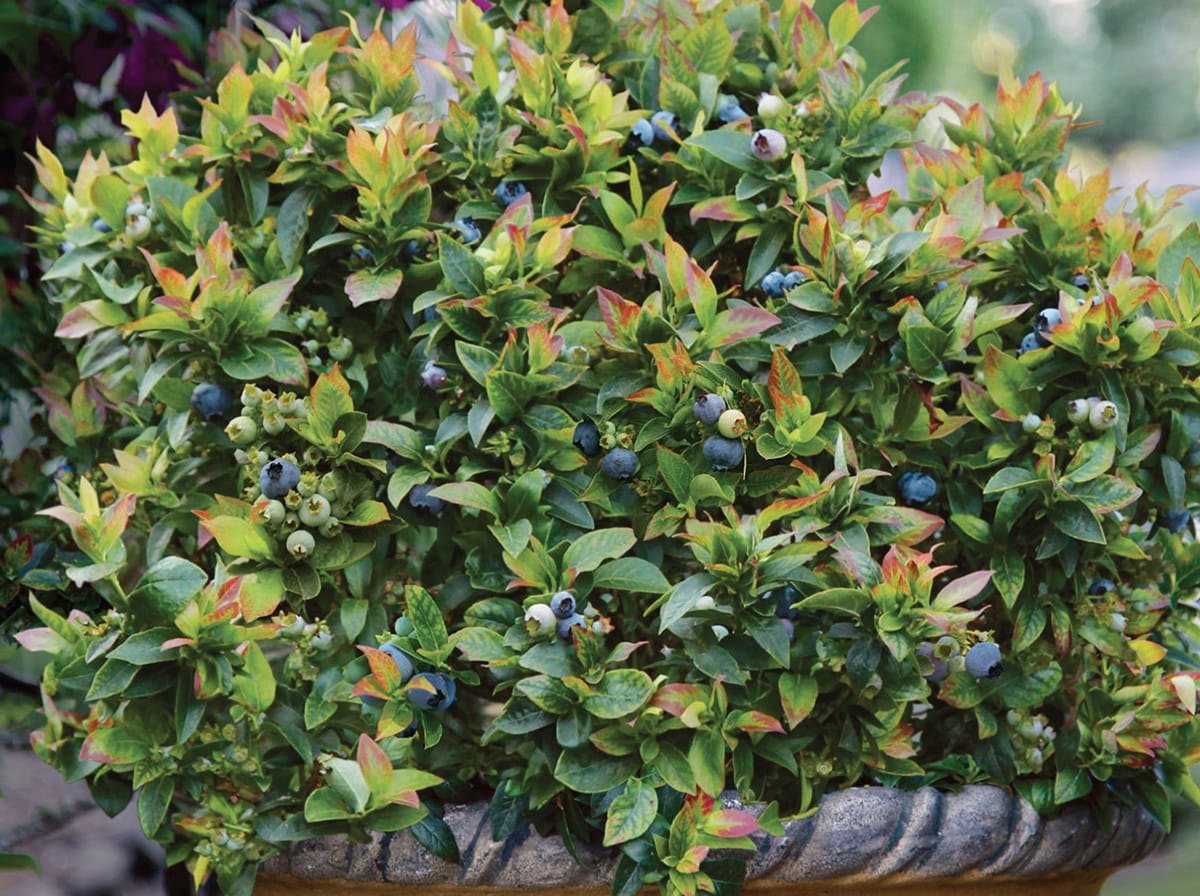
Blueberry Glaze® Blueberry
COMMON NAME: Blueberry Glaze® Blueberry
BOTANICAL NAME: Vaccinium × ‘ZF08-095’
MATURE DIMENSIONS: 2 to 3 feet tall; equal spread
PHYSICAL APPEARANCE: The foliage and growth habit of Blueberry Glaze® make it look a lot like a boxwood, except it produces little, white, bell-shaped blooms, and dark, delicious fruit. This is an interspecies hybrid that requires fewer chill hours (a chill hour is an hour at a temperature below 45°F) than some other blueberries, making it suitable to all but the southernmost garden. The glossy leaves have a lovely fall color.
PLANTING TIPS: Winter hardy down to –20°F, this is a blueberry that makes a great hedge or foundation plant, in addition to containers or mass plantings. Plants are available in the nursery trade and should be planted 4 to 5 feet apart or one plant per 10-gallon container.
CARE REQUIREMENTS: Blueberry Glaze® is self-pollinating, so there’s no need to have multiple varieties for fruit set. Fertilize with an acid-specific fertilizer every 2 years and prune in late winter to remove older canes. Potted plants must be overwintered in a garage or shed or sunk into the ground up to the pot’s rim.
HARVEST TIME: Midsummer
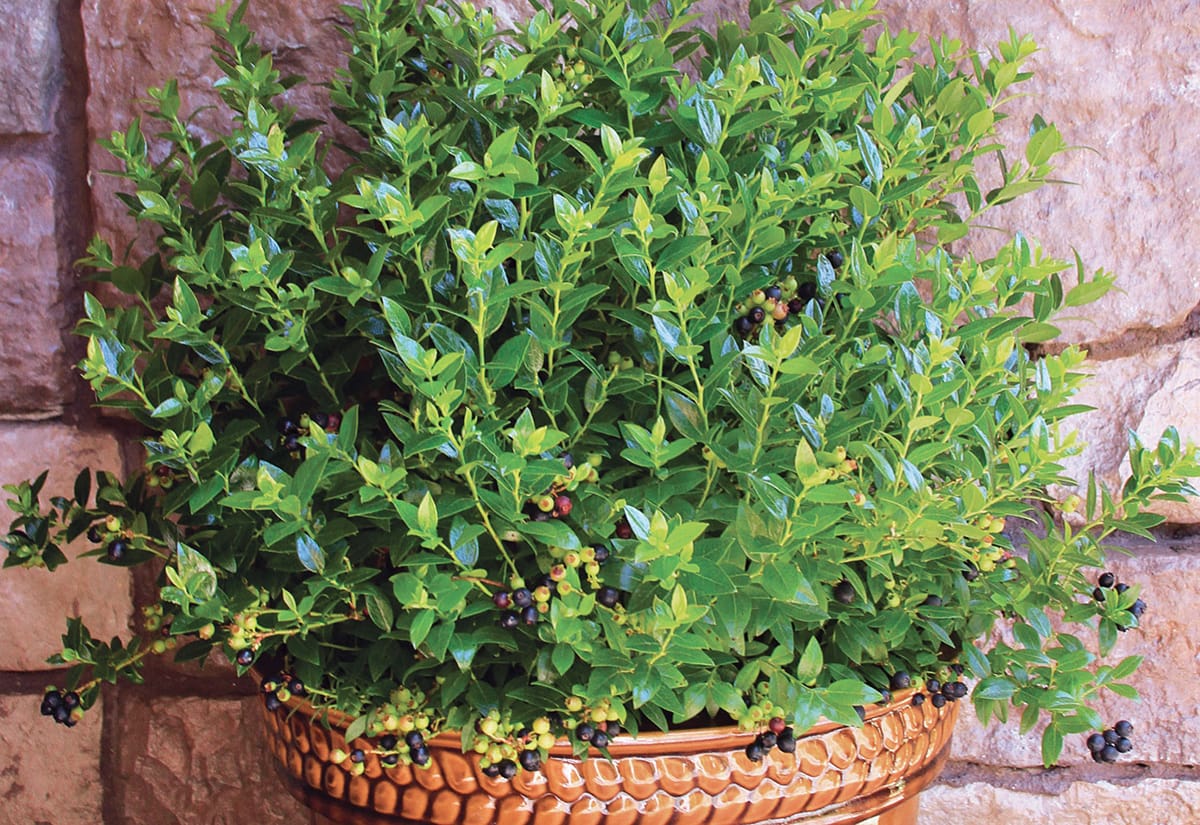
Loran Strawberry
COMMON NAME: Loran Strawberry
BOTANICAL NAME: Fragaria ananassa ‘Loran’
MATURE DIMENSIONS: 6 to 8 inches tall; 10 to 12 inches wide
PHYSICAL APPEARANCE: A perfectly petite strawberry that’s at home in any landscape, ‘Loran’ is a European variety. Its early white flowers are followed by big fruit that’s produced in waves off and on, all season long. The compact plants have lush green leaves, and the berries are cone-shaped and oh so sweet.
PLANTING TIPS: This ever-bearing variety provides a handful of berries every day, all season long. Plant them 6 inches apart to make an edible border, or tuck six of them in an 18-inch pot. They’re winter hardy down to –20°F.
CARE REQUIREMENTS: ‘Loran’ produces few to no runners, so it’s clump forming and not prone to spreading all over the garden. To overwinter the plants in the garden, use a straw mulch layer. For potted berries, move the container to a garage or shed or sink the pot into ground for the winter. Dig up and replace the plants every 4 to 5 years to rejuvenate your berry patch.
HARVEST TIME: Early summer through fall
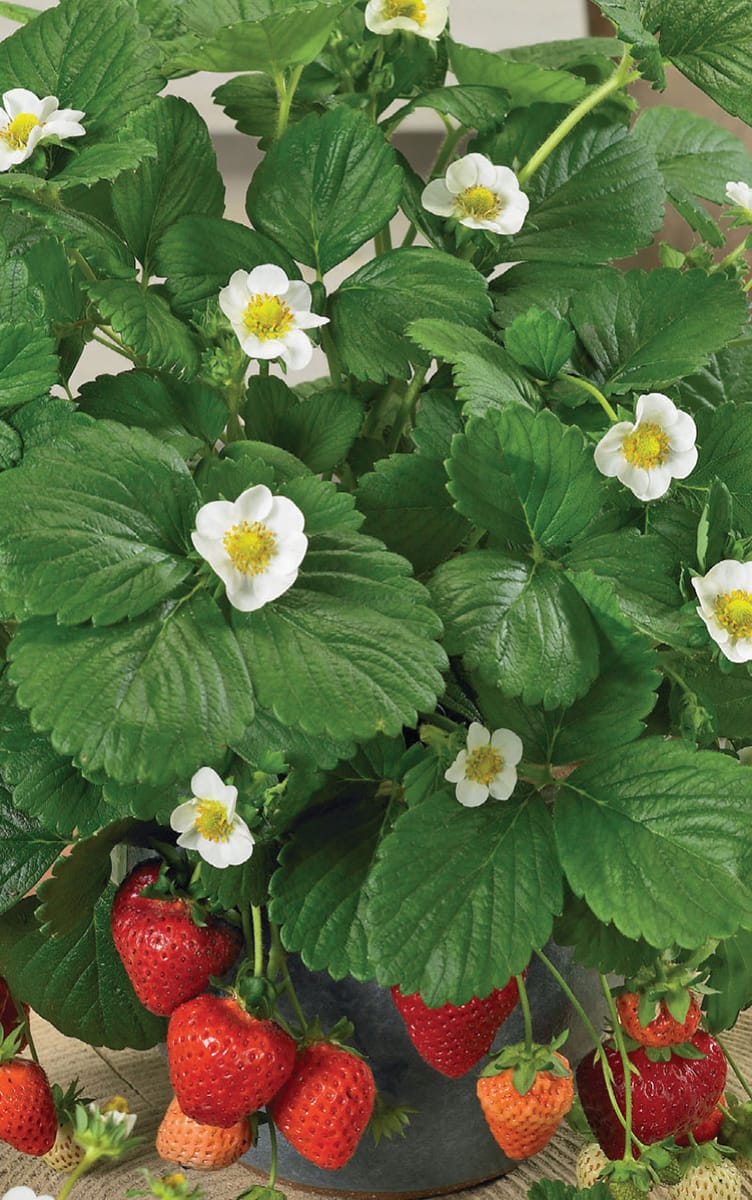
Alpine Strawberry
COMMON NAME: Alpine Strawberry
BOTANICAL NAME: Fragaria vesca
MATURE DIMENSIONS: 6 to 8 inches tall; equal spread
PHYSICAL APPEARANCE: There are several different cultivars on the market, but all alpine strawberries bear small, super sweet berries that have a lovely fragrance. There are both red-fruited and white-fruited varieties, both of which offer an intense flavor. The ever-bearing nature of these plants means berries are produced off and on, all season long.
PLANTING TIPS: Alpine strawberry plants are easy to grow from seed and often produce the same year the seeds are sown. You can also grow them from transplants. Space the plants 10 to 12 inches apart, or plant six plants per 18-inch container. This fruit looks great as a groundcover, slope cover, bed edging, or in window boxes.
CARE REQUIREMENTS: Winter hardy down to –20°F, Alpine strawberries are tough little plants. Provide a winter mulch of straw and divide the plants every 3 to 4 years. These strawberries do not send out runners. If you grow them in containers, overwinter the pot in a garage or shed or sink the pot into the ground until spring’s arrival.
HARVEST TIME: Summer through fall
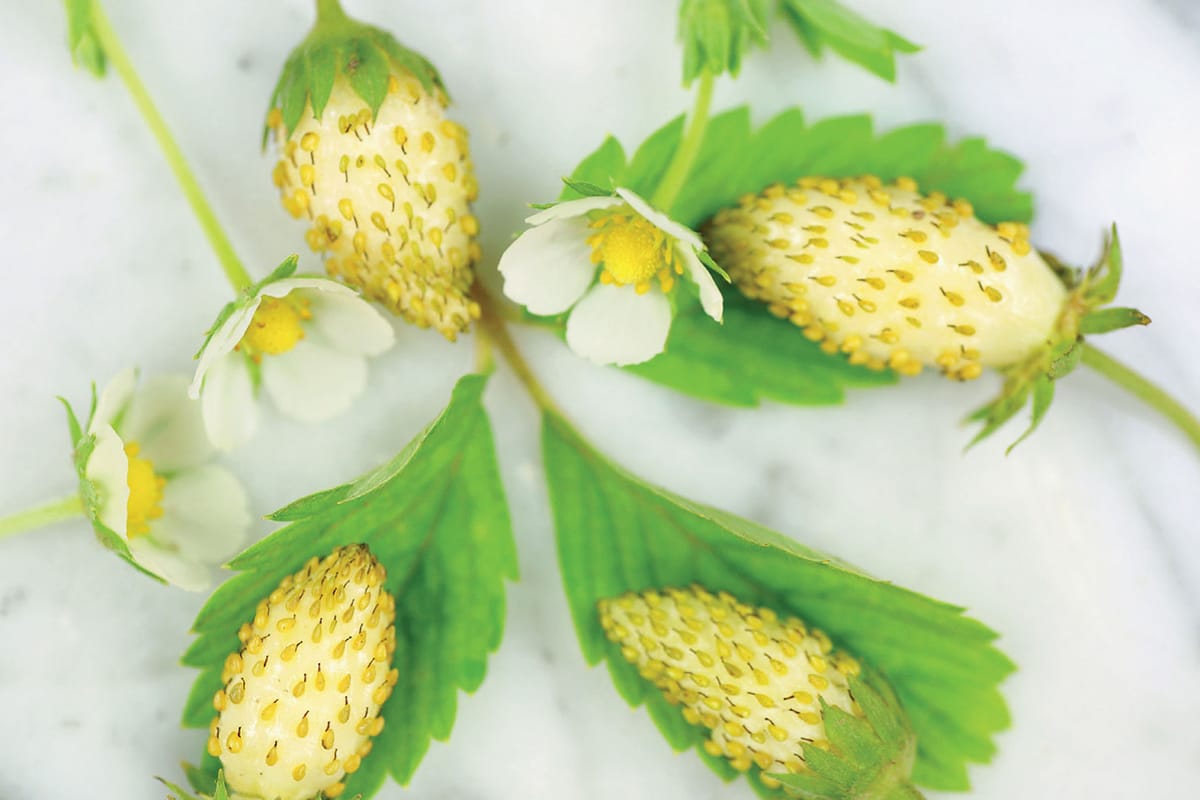
Urban Apple® Columnar Apple
COMMON NAME: Urban Apple® Columnar Apple
BOTANICAL NAME: Malus × domestica Urban Apple®
MATURE DIMENSIONS: 8 to 10 feet tall; 2 feet wide
PHYSICAL APPEARANCE: A columnar, narrow apple tree that fits in the tightest of spaces? Yes, please! The Urban Apple® line of apple trees has full-sized leaves and fruits but is at home in even the tiniest of backyards. There are several different varieties, including Tasty Red™, Golden Treat™, Blushing Delight™, and Tangy Green™. The fruiting spurs are tight against the trunk and the branching is upright, making these trees exceptional choices for those looking to utilize vertical space. As an added bonus, the trees often bear fruit the first year of planting.
PLANTING TIPS: Not all apple varieties are suited to all climates. Apples require a set number of chill hours to produce flowers (a chill hour is an hour at a temperature below 45°F). Apple varieties that require a high number of chill hours can’t be grown in warmer climates or they won’t set buds, while those requiring a low number of chill hours are best for more southern regions where they won’t flower too early and get frosted. Urban Apple® trees require between 800 and 1,200 chill hours for the best bud set, making them suitable for most gardens in USDA hardiness zones 4 through 8, a far broader range than many other apples. Space trees 4 to 5 feet apart, or plant one tree per 15- to 20-gallon container.
CARE REQUIREMENTS: Apples are not self-fertile; you’ll need to have at least two different varieties in order for cross-pollination and fruit set to occur. Be sure to water Urban Apples® regularly until they’re established. Prune the trees in the late winter.
HARVEST TIME: Summer through fall, depending on which variety is planted
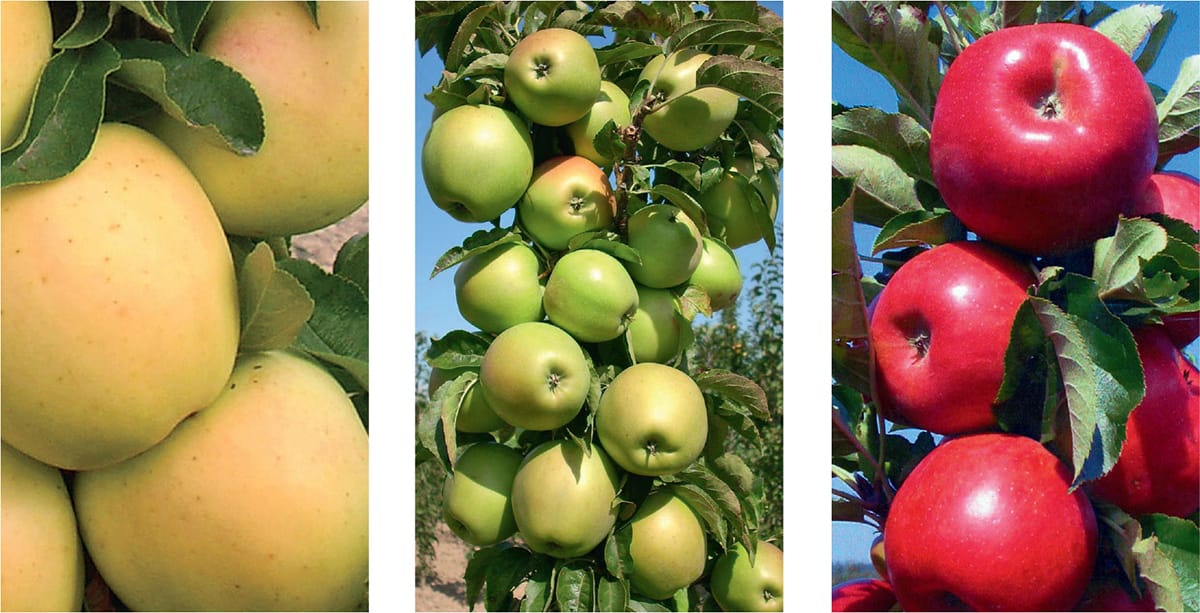
Pix Zee™ Peach
COMMON NAME: Pix Zee™ Peach
BOTANICAL NAME: Prunus persica ‘Pix Zee’
MATURE DIMENSIONS: 5 to 6 feet tall; 4 to 5 feet wide
PHYSICAL APPEARANCE: Pix Zee™ peach is a true genetic dwarf variety that produces full-sized foliage and fruit. It’s simply spectacular! The peaches are freestone with yellow flesh and red-orange skin. The tree is covered with pink blossoms in the spring, and the peaches are firm and flavorful.
PLANTING TIPS: This peach variety requires fewer than 400 hours below 45°F (called chill hours) between November and March to develop flower buds. This means that the flowers may open too early in northern climates and be destroyed by spring frosts, but it also means that you can grow Pix Zee™ peaches in southern climates, where other peaches that require more chill hours may not thrive. Winter hardy down to –10°F, this peach is great for small kitchen gardens. It’s grafted onto a different root stock, so don’t bury too deeply or suckering may occur.
CARE REQUIREMENTS: Pix Zee™ is self-fertile, which means no cross-pollination is necessary; you’ll get plenty of peaches with just one tree. Prune the trees in late winter and protect from frosts when in bloom. Potted trees can be overwintered in an unheated garage in the north, or sink the pot into the garden to overwinter outdoors.
HARVEST TIME: Midsummer

Necta Zee™ Nectarine
COMMON NAME: Necta Zee™ Nectarine
BOTANICAL NAME: Prunus persica var. nucipersica (or var. nectarina) ‘Necta Zee’
MATURE DIMENSIONS: 4 to 5 feet tall; 3 to 4 feet wide
PHYSICAL APPEARANCE: This yellow-fleshed, freestone dwarf nectarine has smooth, red skin. Despite its small stature, Necta Zee™ is very productive, producing dozens of nectarines in a garden or container.
PLANTING TIPS: Requiring 400 or fewer chill hours below 45°F between November and March in order to develop flower buds, this variety may bloom too early in the north, but it’s perfectly suited to warmer climes where other nectarines may prove more difficult to grow. The trees are winter hardy down to –10°F, and since no cross-pollination is necessary, only one tree is needed for good fruit production. Necta Zee™ is grafted onto a different root stock; don’t bury too deeply or suckering may occur.
CARE REQUIREMENTS: If frost threatens when the tree is in bloom, cover with a frost cloth or bedsheet to protect it. In cold climates, overwinter potted trees in a garage or sink the pot in the ground up to its rim. Prune in late winter.
HARVEST TIME: Midsummer

Pixie™ Grapes
COMMON NAME: Pixie™ Grapes
BOTANICAL NAME: Vitis vinifera
MATURE DIMENSIONS: 18 to 24 inches tall; 12 inches wide
PHYSICAL APPEARANCE: If you’ve always wanted to grow grapes but don’t think you have the room, this line of dwarf grape plants is the answer! Originally developed for research purposes, their short internodes mean they produce lots of flowers instead of long, vining tendrils. There are several different varieties available, including Pinot Meunier, Riesling, and Cabernet Franc. These perfectly petite grape vines are ideal for urban gardens. The fruit clusters are about 4 to 5 inches long and quite tasty.
PLANTING TIPS: Winter hardy down to –30°F, Pixie™ grapes can be grown in the ground with a plant spacing of 3 to 4 feet or in a pot with one plant per 3-gallon container.
CARE REQUIREMENTS: Though the plants stay compact, you’ll need to provide them with a vertical support or the grape clusters will sit on the ground. A small trellis will do. Fertilize the vines with a complete, granular, organic fertilizer every 5 weeks; but stop in midsummer to slow growth and ripen the fruit. To overwinter potted plants, move the pot into a cold garage or bury it in the soil up to its rim. Prune the vines in late winter.
HARVEST TIME: Summer through early fall
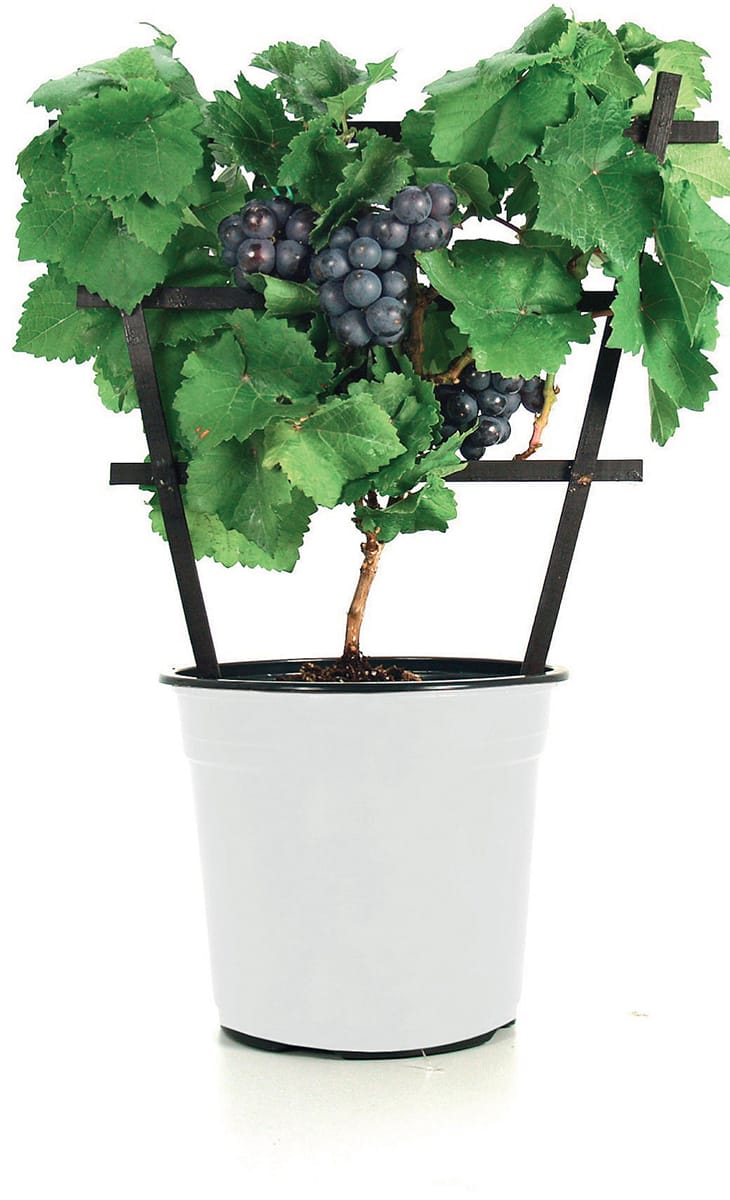
VEGETABLES
Peas-in-a-Pot Sweet Peas
COMMON NAME: Peas-in-a-Pot Sweet Peas
BOTANICAL NAME: Pisum sativum var. sativum ‘Peas-in-a-pot’
MATURE DIMENSIONS: 10 inches tall; 4 inches wide
PHYSICAL APPEARANCE: These peas are cute as can be! Tiny plants bear 3- to 4-inch-long pods filled with plump green peas. The white flowers look lovely in mixed-container plantings, and as long as you regularly harvest the pods, production will continue until hot weather arrives.
PLANTING TIPS: Peas are a cool-season crop. Sow seeds directly into the garden in early spring for an early summer harvest or late summer for a fall harvest. Plant peas 1 inch deep and 2 inches apart. Use pea inoculant to improve the germination and growth of all pea varieties (this is especially important if you grow peas in pots).
CARE REQUIREMENTS: ‘Peas-in-a-pot’ sweet peas mature in 60 to 65 days from the sow date. There’s no need to stake these little marvels. Harvest when the pods are swollen but still green.
HARVEST TIME: Early summer or late fall
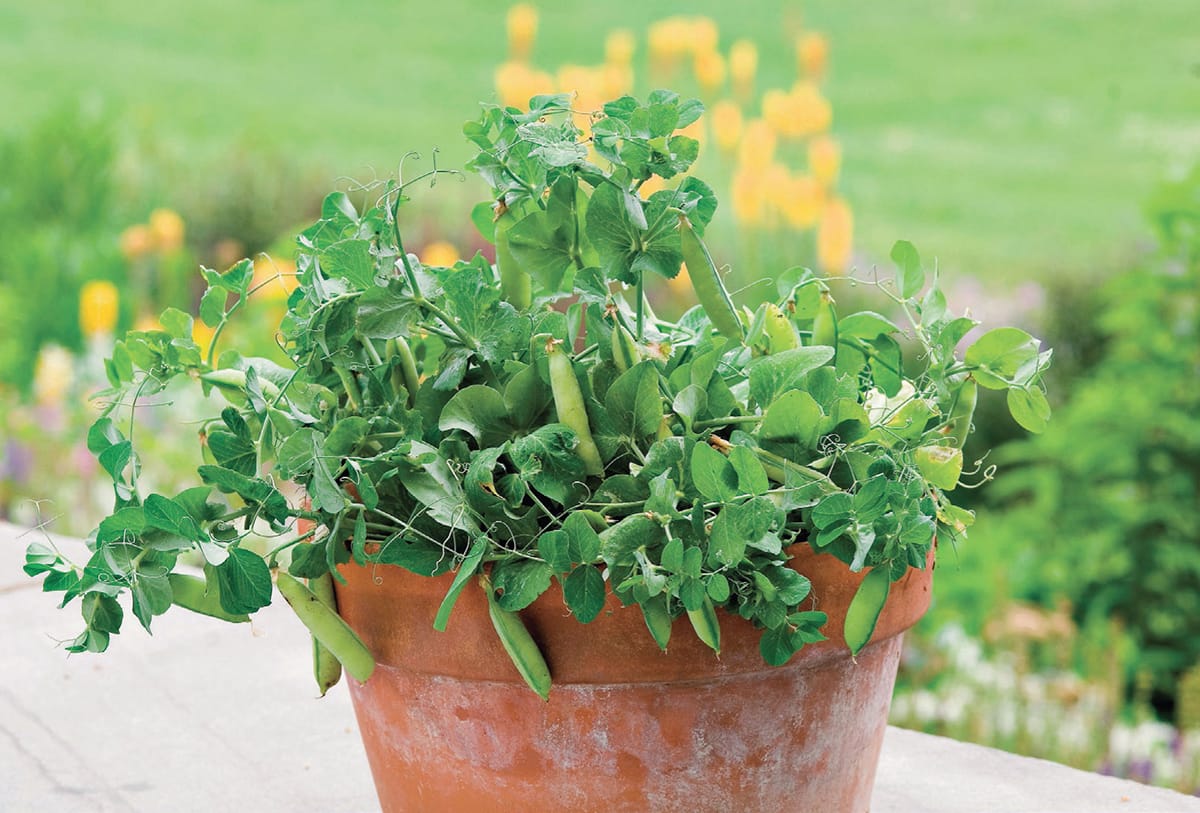
Little SnapPea Crunch Sugar Snap Peas
COMMON NAME: Little SnapPea Crunch Sugar Snap Peas
BOTANICAL NAME: Pisum sativum var. macrocarpon ‘Little SnapPea Crunch’
MATURE DIMENSIONS: 24 to 28 inches tall; 8 to 12 inches wide
PHYSICAL APPEARANCE: This edible-podded snap pea produces a plethora of plump, sweet pods on plants that are about a third the height of standard varieties. Three-inch-long pods follow lovely white flowers. The plants are fairly heat tolerant, too.
PLANTING TIPS: Peas are a cool-season crop, so sowing very early or late in the season is essential. Sow seeds directly into the garden or container, 1 inch deep and 2 inches apart. Use pea inoculant to improve the growth and germination of all pea varieties, especially if you’re growing in containers. ‘Little SnapPea Crunch’ looks great mixed into flower borders, in containers, or in raised beds.
CARE REQUIREMENTS: There’s no need to stake this variety, as the compact vines are self-supporting. Pods are ready to harvest when they’re swollen and the peas inside have filled out, about 58 to 60 days after planting.
HARVEST TIME: Early summer or late fall
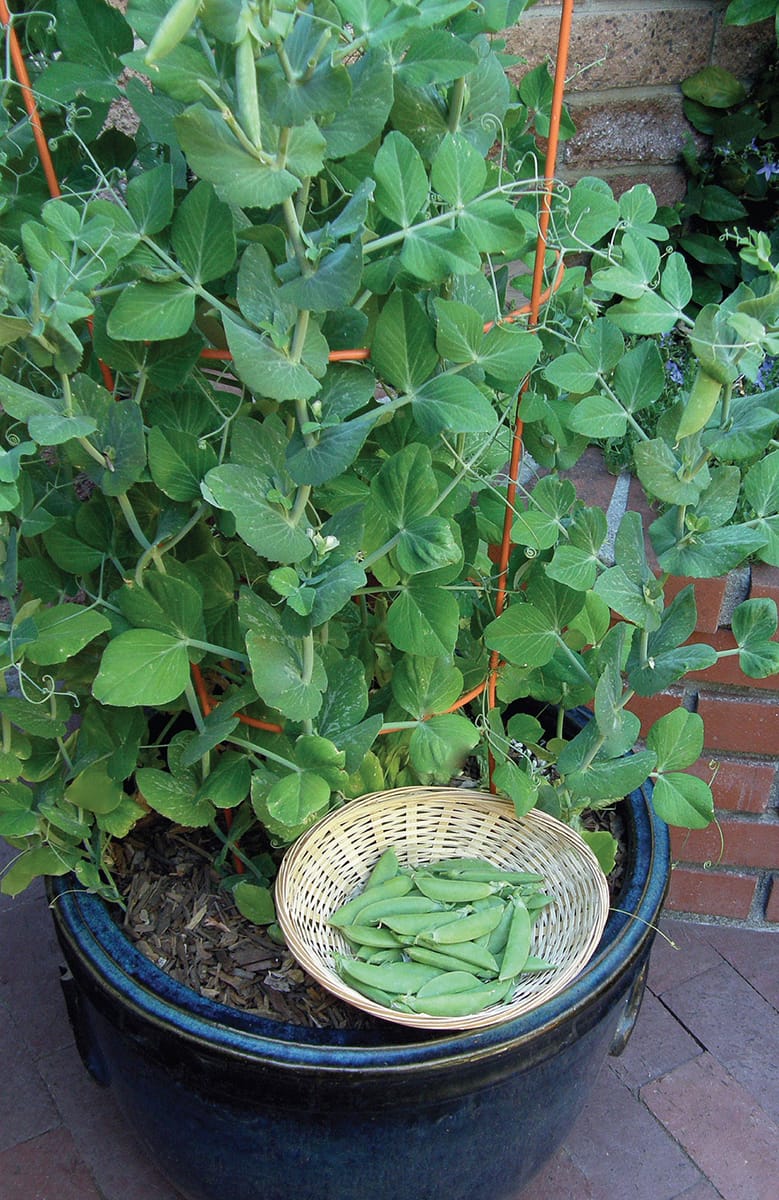
On Deck Sweet Corn
COMMON NAME: On Deck Sweet Corn
BOTANICAL NAME: Zea mays convar. saccharata var. rugosa ‘On Deck’
MATURE DIMENSIONS: 4 to 5 feet tall; 12 to 18 inches wide
PHYSICAL APPEARANCE: If you don’t think you have enough room to grow sweet corn, you’d be wise to think again. ‘On Deck’ is a super sweet, hybrid, bicolor corn bred just for small gardens and containers. Each plant produces two to three ears that are 7 to 8 inches long. It has a classic corn plant look, but at half the height of standard varieties.
PLANTING TIPS: Corn is wind pollinated, so you’ll have to plant this crop in groups of at least 10 plants for decent kernel formation. The soil must be over 60°F before planting seeds or they may fail to germinate. Plant the seeds only after the danger of frost has passed. Seeds are sown 1 inch deep and 5 inches apart. If you choose to grow ‘On Deck’ in a container, be sure to select a large pot that can hold at least 10 to 12 full-grown stalks.
CARE REQUIREMENTS: Plants do not need to be staked, but don’t plant ‘On Deck’ near other varieties of corn or cross-pollination could occur and cause the kernels to be starchy. Separate corn varieties by at least 250 feet; that includes any nearby field corn. The ears are ready for harvest 60 to 65 days after seeding.
HARVEST TIME: Mid- to late summer
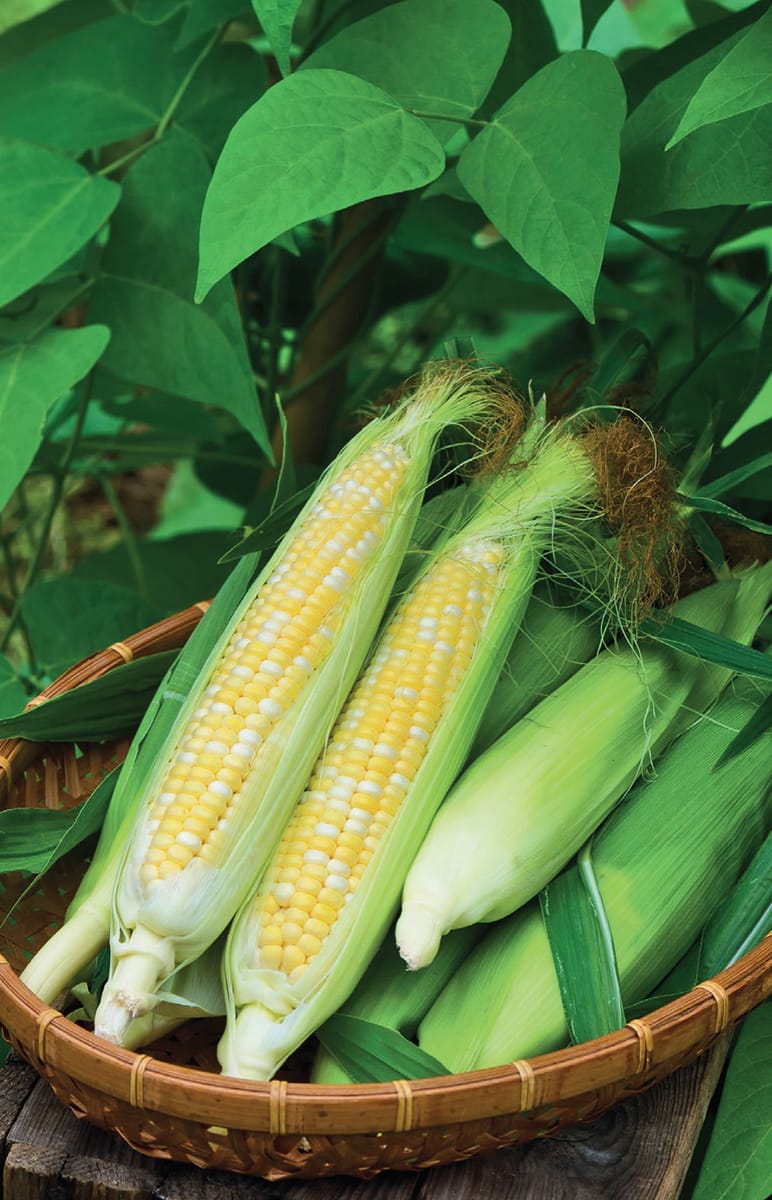
Blue Jade Dwarf Corn
COMMON NAME: Blue Jade Dwarf Corn
BOTANICAL NAME: Zea mays convar. saccharata var. rugosa ‘Blue Jade’
MATURE DIMENSIONS: 3 feet tall; 10 inches wide
PHYSICAL APPEARANCE: The stalks of this variety are half the height of traditional sweet corn varieties, and the kernels are an amazing deep steel blue at maturity! ‘Blue Jade’ is an open-pollinated heirloom sweet corn that’s been grown for generations. The ears are ready to harvest 70 to 80 days after sowing, with each cob measuring 4 to 5 inches long.
PLANTING TIPS: Sow seeds directly into garden soil only after it’s reached 60°F and the danger of frost has passed. Plant seeds 1 inch deep and 6 inches apart. Corn is wind pollinated, so you’ll need to plant ‘Blue Jade’ in a block of at least 20 plants for good kernel set.
CARE REQUIREMENTS: The stalks are self-supporting, but they’re also heavy feeders. Add supplemental fertilizer in the spring. To avoid accidental cross-pollination that will likely result in starchy kernels, isolate ‘Blue Jade’ from other corn varieties by at least 250 feet.
HARVEST TIME: Mid- to late summer
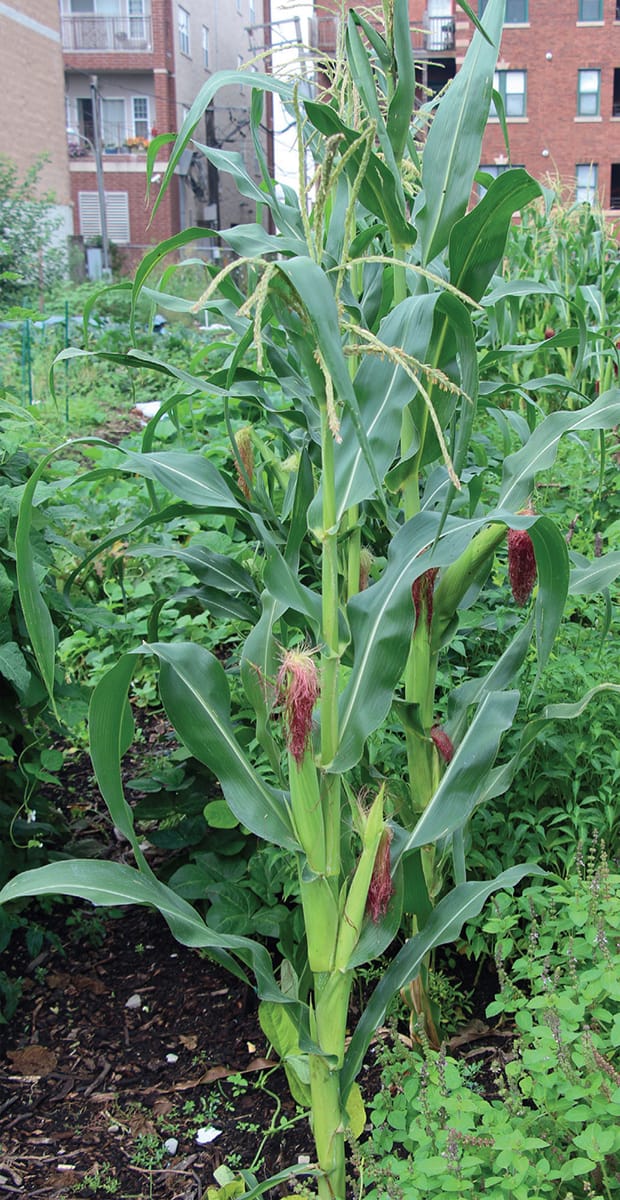
Baby Ball Beets
COMMON NAME: Baby Ball Beets
BOTANICAL NAME: Beta vulgaris ‘Baby Ball’
MATURE DIMENSIONS: 8 inches tall; 5 inches wide
PHYSICAL APPEARANCE: ‘Baby Ball’ is a Dutch variety of petite beets that’s an amazing gourmet treat. The perfect red orbs are sweet and tender, and they measure just 1 to 11/2 inches in diameter. Ready to harvest 45 to 55 days after sowing, ‘Baby Ball’s’ greens are edible, too.
PLANTING TIPS: Beets can be planted anytime the ground can be worked in early spring through late summer. Sow seeds directly into the garden or a container 1/2 inch deep and 2 to 3 inches apart. Each beet seed contains multiple embryos, so when the seedlings are about 1 inch tall, thin them to give each root plenty of room to grow.
CARE REQUIREMENTS: For optimum germination, keep the soil evenly moist. Beets are fairly cold tolerant. Protect the plants from frosts with floating row cover or a cold frame to prolong the harvest well into fall and early winter.
HARVEST TIME: Late spring though early winter
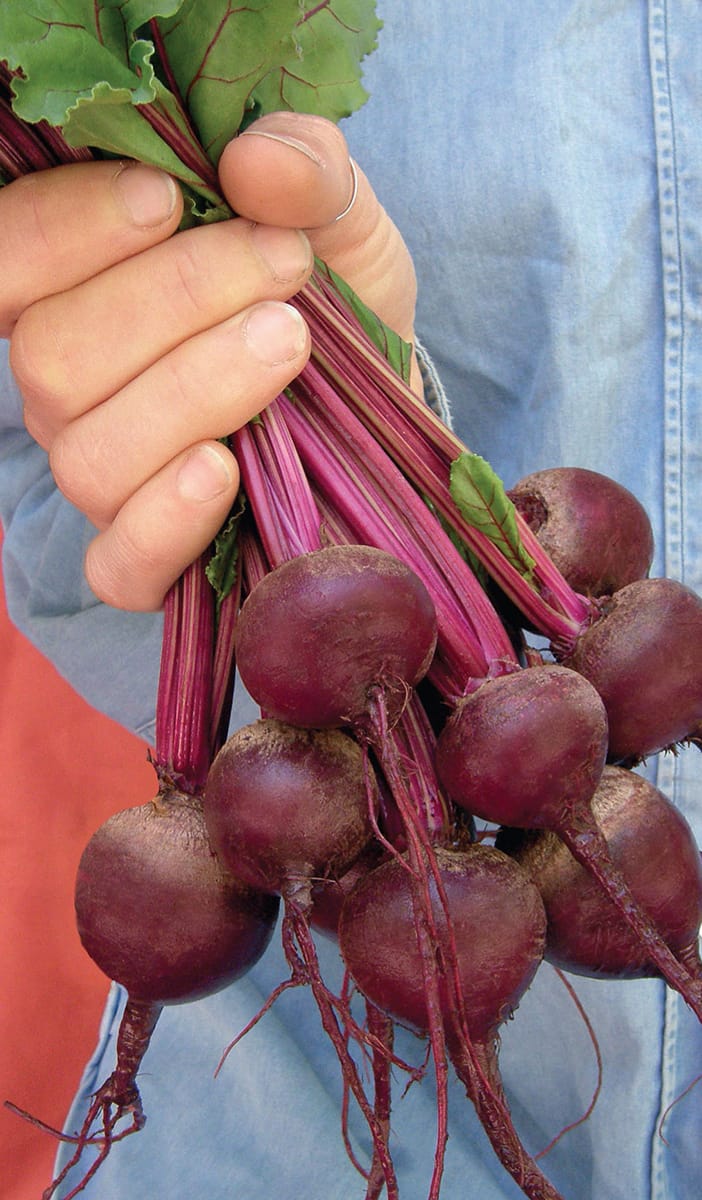
Tiara Cabbage
COMMON NAME: Tiara Cabbage
BOTANICAL NAME: Brassica oleracea var. capitata ‘Tiara’
MATURE DIMENSIONS: 10 to 12 inches tall; 12 to 18 inches wide
PHYSICAL APPEARANCE: ‘Tiara’ is a beautiful hybrid minicabbage variety. It’s early to produce, and its small, tight, round heads average 3 pounds each. Each cabbage produces a beautiful rosette of leaves that surrounds the head. ‘Tiara’ is perfect for high-density plantings or in small areas or containers.
PLANTING TIPS: It’s best to start seeds indoors under grow lights 10 to 12 weeks before your last expected spring frost. Cabbage is a cool-season crop that’s quite tolerant of light frosts. The transplants can go out into the garden when they’re about 6 weeks old. Space plants 12 to 18 inches apart or plant one plant per 3-gallon pot. ‘Tiara’ also can be grown as a fall crop.
CARE REQUIREMENTS: Be sure to keep the soil evenly moist. If you provide a lot of water after a dry spell, the heads may crack open. Mulching helps prevent this. ‘Tiara’ requires 50 days to mature from transplant. To harvest cabbage, cut the head from plant using a sharp knife.
HARVEST TIME: Midsummer through fall in the north, fall through spring in the south
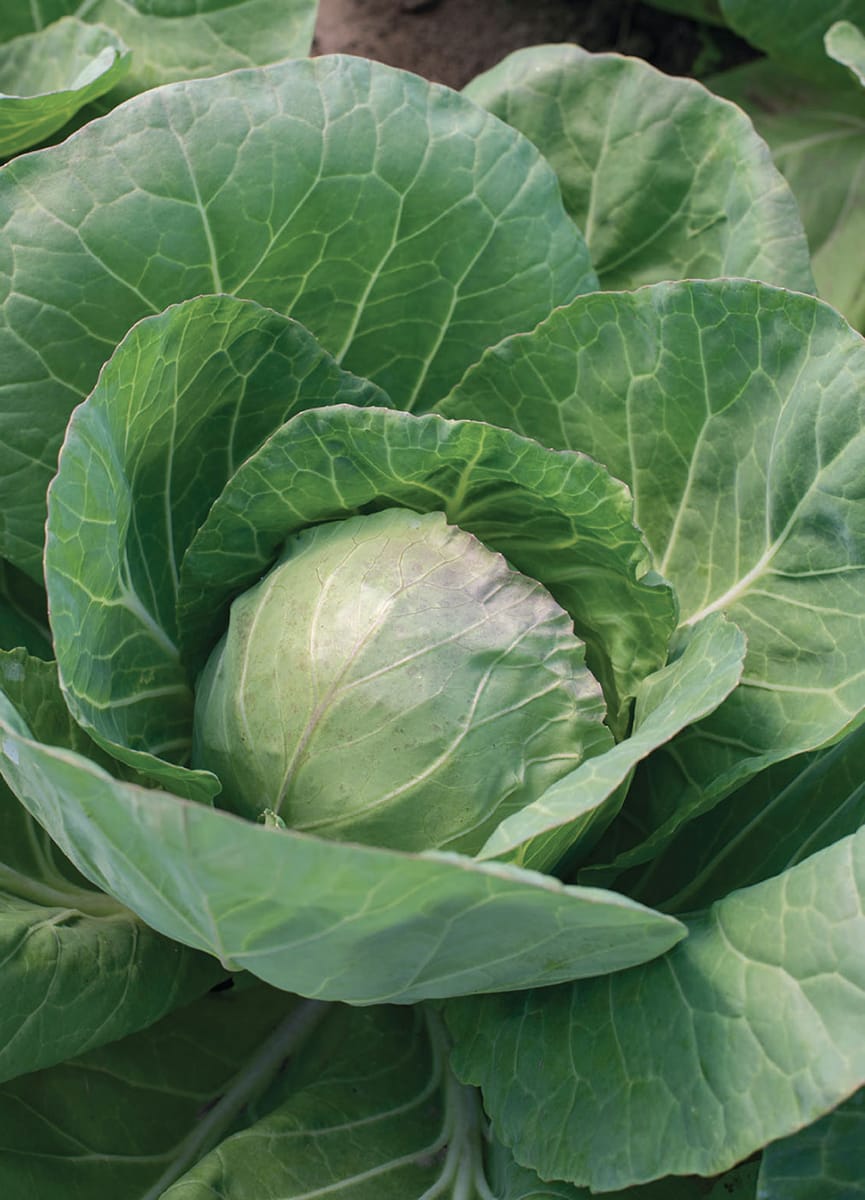
Thumbelina Carrot
COMMON NAME: Thumbelina Carrot
BOTANICAL NAME: Daucus carota subsp. sativus ‘Thumbelina’
MATURE DIMENSIONS: 8 to 10 inches tall; 3 inches wide
PHYSICAL APPEARANCE: If ever there were a prize for the most adorable carrot, ‘Thumbelina’ would get the blue ribbon. These small, round carrots are bright orange and sweet enough to be eaten raw or cooked. An open-pollinated variety, ‘Thumbelina’s’ skin is so thin it doesn’t need to be peeled. This golf ball–sized carrot is ideal for gardens with rocky or heavy clay-based soils. It also does great in patio pots.
PLANTING TIPS: To plant carrots, sow seeds directly into the ground anytime from early spring through early autumn. Carrots grow well in both cool and warm seasons, though young plants won’t do well in excessive summer heat. Sow seeds 1/4 inch deep and 1 inch apart, but thin the seedlings to a 3-inch spacing when they’re young. Be warned that carrot seeds take a long time to germinate, sometimes over 2 weeks.
CARE REQUIREMENTS: ‘Thumbelina’ carrots are easy to grow and ready to harvest just 60 days after planting. Mulch the rows to conserve moisture, and mound soil up over the “shoulders” of near-mature carrots to keep them from turning green.
HARVEST TIME: Early summer through late fall

Little Finger Carrot
COMMON NAME: Little Finger Carrot
BOTANICAL NAME: Daucus carota subsp. sativus ‘Little Finger’
MATURE DIMENSIONS: 6 inches tall; 3 inches wide
PHYSICAL APPEARANCE: ‘Little Finger’ is the perfect name for this baby-type carrot that grows only as wide as a finger. Plus, it’s so crunchy! The slender, 4-inch-long, bright orange roots are well suited to canning and pickling. Its thin skin and sweet flavor make this carrot a gourmet delight.
PLANTING TIPS: Carrot seeds are best planted directly into the garden or a deep container anytime from very early spring through late summer. The roots are ready for harvest 55 days after planting. Sow seeds 1/4 inch deep and 1 inch apart, then thin the seedlings to 2 to 3 inches apart. Carrot seeds are very slow to germinate; sometimes it takes 2 to 3 weeks.
CARE REQUIREMENTS: Get rid of any rocks or lumpy soil prior to planting or the roots will fork or be misshapen. Keep the seedbed evenly moist and mulch the roots to keep weed competition at a minimum. Sow more seeds every few weeks for a continual harvest.
HARVEST TIME: Early summer through late fall
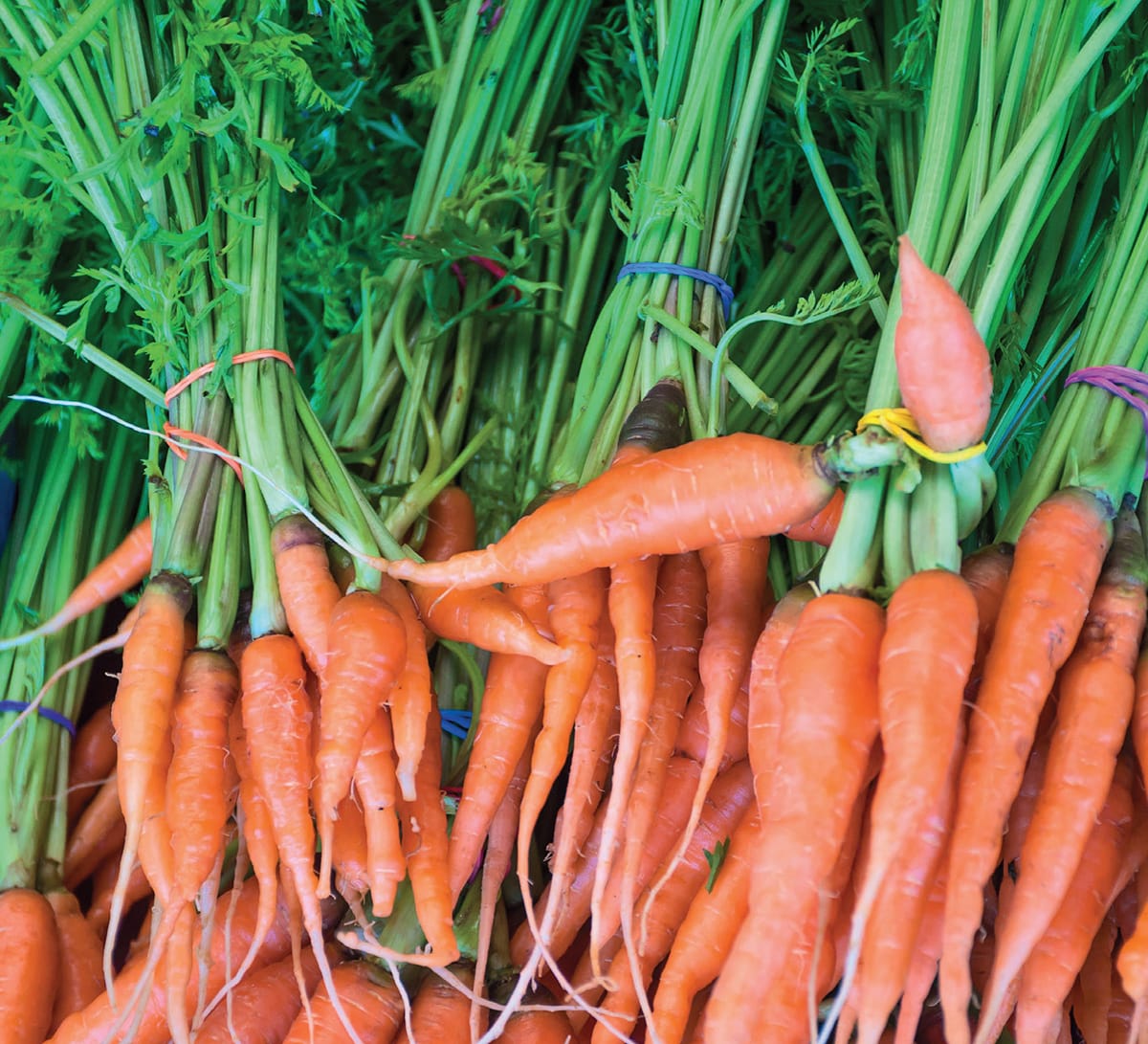
French Mascotte Bush Bean
COMMON NAME: French Mascotte Bush Bean
BOTANICAL NAME: Phaseolus vulgaris ‘French Mascotte’
MATURE DIMENSIONS: 20 inches tall; 16 inches wide
PHYSICAL APPEARANCE: ‘French Mascotte’ is more than just a pretty plant. It produces long, slender green beans that are held atop lush green foliage. Its white to lavender flowers are lovely, too. A French variety that’s both incredibly productive and disease resistant, the straight beans are 5 inches long, stringless, and delectably flavored.
PLANTING TIPS: Seeds are best planted directly into the garden or a container after the danger of frost has passed and nighttime temperatures stay above 55°F. Plant them 1 inch deep and 4 inches apart. Soaking the seeds for a few hours prior to planting speeds the germination rate but isn’t necessary. Beans are ready for harvest 54 days after planting.
CARE REQUIREMENTS: Like many other green bean varieties, the more you pick ‘French Mascotte’, the more beans the plants will produce. The pods are very easy to harvest due to the way the beans grow above the plant tops. This bush variety does not need to be staked or otherwise supported.
HARVEST TIME: Summer
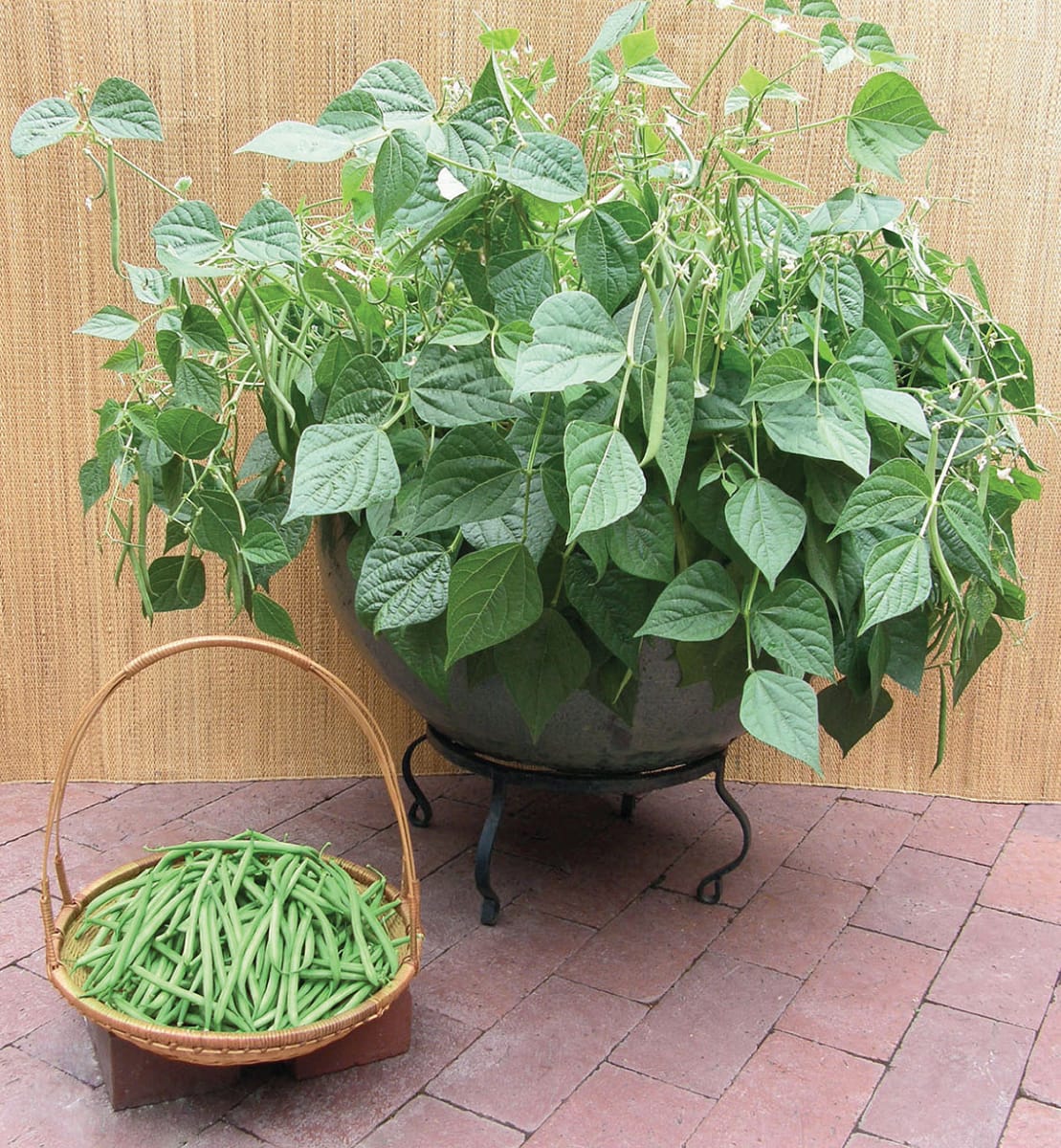
Patio Snacker Cucumber
COMMON NAME: Patio Snacker Cucumber
BOTANICAL NAME: Cucumis sativus ‘Patio Snacker’
MATURE DIMENSIONS: 10 to 12 inches tall; 2 to 3 feet wide
PHYSICAL APPEARANCE: Once you grow this compact cuke, you’ll be hooked. It’s hard to believe how many 6-inch-long, slender fruits are produced on such small plants. With very short vines, this hybrid variety is ideal for pots and itty-bitty backyards. Like other cucumbers, the plants bear separate male and female flowers. But unlike many other varieties, ‘Patio Snacker’ doesn’t need to have a lot of pollinators around to produce fruit. The flowers are parthenocarpic, meaning they have the ability to set fruit without insect pollination, making this an excellent choice for urban areas and balcony gardens where pollinators may be in limited supply.
PLANTING TIPS: ‘Patio Snacker’ cucumbers are ready to harvest just 55 days after planting the seeds. Wait to plant until the soil temp reaches at least 65°F and the danger of frost has passed. Sow seeds 1/2 to 1 inch deep and space plants 3 feet apart, or plan on one plant per 3-gallon container.
CARE REQUIREMENTS: Use a small trellis or fence to support the vines, or let them spill out over the edge of a container. Harvest the cucumbers on a continual basis for more production. With all cucumbers, consistent, even moisture is critical for good fruit development.
HARVEST TIME: Summer through fall
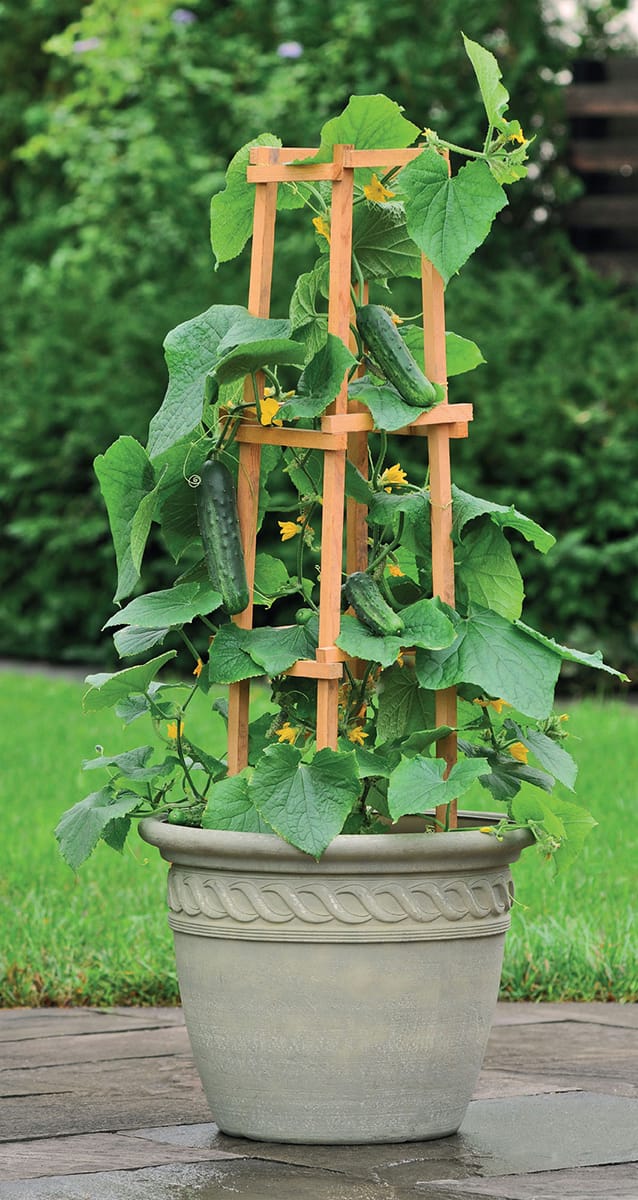
Salad Bush Cucumber
COMMON NAME: Salad Bush Cucumber
BOTANICAL NAME: Cucumis sativus ‘Salad Bush’
MATURE DIMENSIONS: 2 feet tall; equally as wide
PHYSICAL APPEARANCE: A bush type that doesn’t vine, this hybrid cuke needs very little space to perform its best. A plethora of 8-inch-long, uniform cucumbers are produced on each disease-resistant plant.
PLANTING TIPS: Sow seeds directly into the garden or containers when the danger of frost has passed and the soil temperature has reached 60°F. Sow more seeds every few weeks to extend your harvest well into the autumn. Seeds are best planted 1/2 to 1 inch deep and 2 feet apart. Cucumbers resent transplanting, so if you choose to start seeds early indoors, be sure to use plantable peat pots so you won’t disturb the roots when moving the plants into the garden.
CARE REQUIREMENTS: With its high disease resistance, ‘Salad Bush’ requires very little care. A 2-inch-thick layer of mulch keeps the soil consistently moist. At harvest time, cut the fruit from the vine; do not pull it. ‘Salad Bush’ is ready to harvest 57 days after planting.
HARVEST TIME: Summer through fall
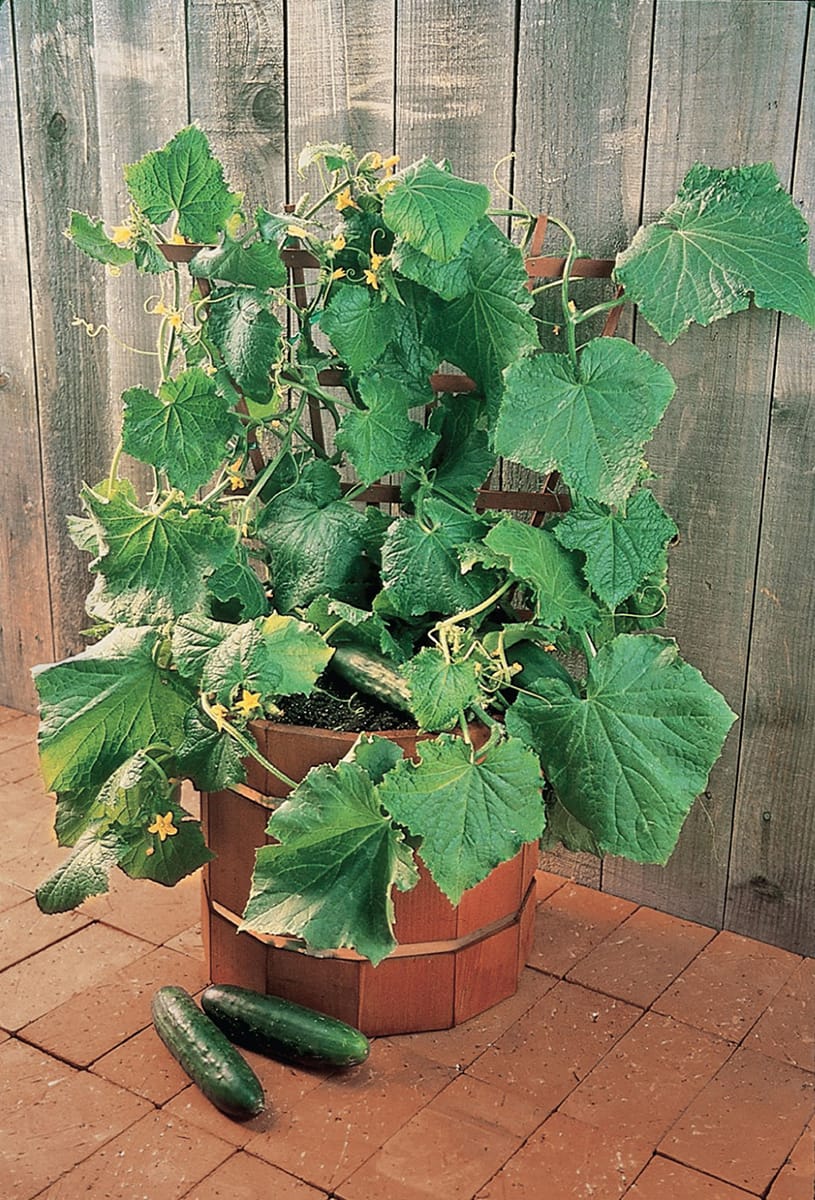
Fairy Tale Eggplant
COMMON NAME: Fairy Tale Eggplant
BOTANICAL NAME: Solanum melongena ‘Fairy Tale’
MATURE DIMENSIONS: 18 to 24 inches tall; 12 to 18 inches wide
PHYSICAL APPEARANCE: An adorable hybrid eggplant that produces small, 2- to 4-inch-long fruits, ‘Fairy Tale’ is a small-space gardener’s dream. The lavender eggplants are streaked with white, have very few seeds, and are bitter free. The fruits are borne in clusters that hang from the plants. So pretty!
PLANTING TIPS: To grow this eggplant, sow seeds indoors under grow lights 6 to 8 weeks before the last expected frost date. Move the plants out into garden only after the danger of frost has passed. Space plants 18 inches apart or plant one plant per 3-gallon container.
CARE REQUIREMENTS: Plan to stake the plants or use cages to keep them upright and to keep the fruits off the ground. The eggplants are ready to cut from the plants 65 days after moving the transplants into the garden. At harvest time, the skin is glossy but the flesh gives a little under pressure from your thumb. If the skin is yellow tinted, the fruits are overripe.
HARVEST TIME: Summer through fall

Patio Baby Eggplant
COMMON NAME: Patio Baby Eggplant
BOTANICAL NAME: Solanum melongena ‘Patio Baby’
MATURE DIMENSIONS: 16 to 24 inches tall; equal spread
PHYSICAL APPEARANCE: These compact hybrid plants are great for patio pots and urban gardens. Dark purple, egg-shaped, glossy fruits are 2 to 3 inches long and wide. Their thin skins make them great for roasting. Each plant produces many small fruits per cluster. This is a great variety for short growing seasons.
PLANTING TIPS: Sow seeds indoors under grow lights 6 to 8 weeks before the last expected frost date. Then, move plants outdoors when danger of frost has passed. Space the plants about 18 inches apart or plant one plant per 3-gallon container.
CARE REQUIREMENTS: The more you harvest, the more fruits this variety sets; and since the plants are spineless, picking is easy. Compact plants mean no staking is necessary. When ripe, cut the fruits from the plant; do not tear. ‘Patio Baby’ is ready to harvest just 50 days after transplanting out into the garden.
HARVEST TIME: Summer through early fall
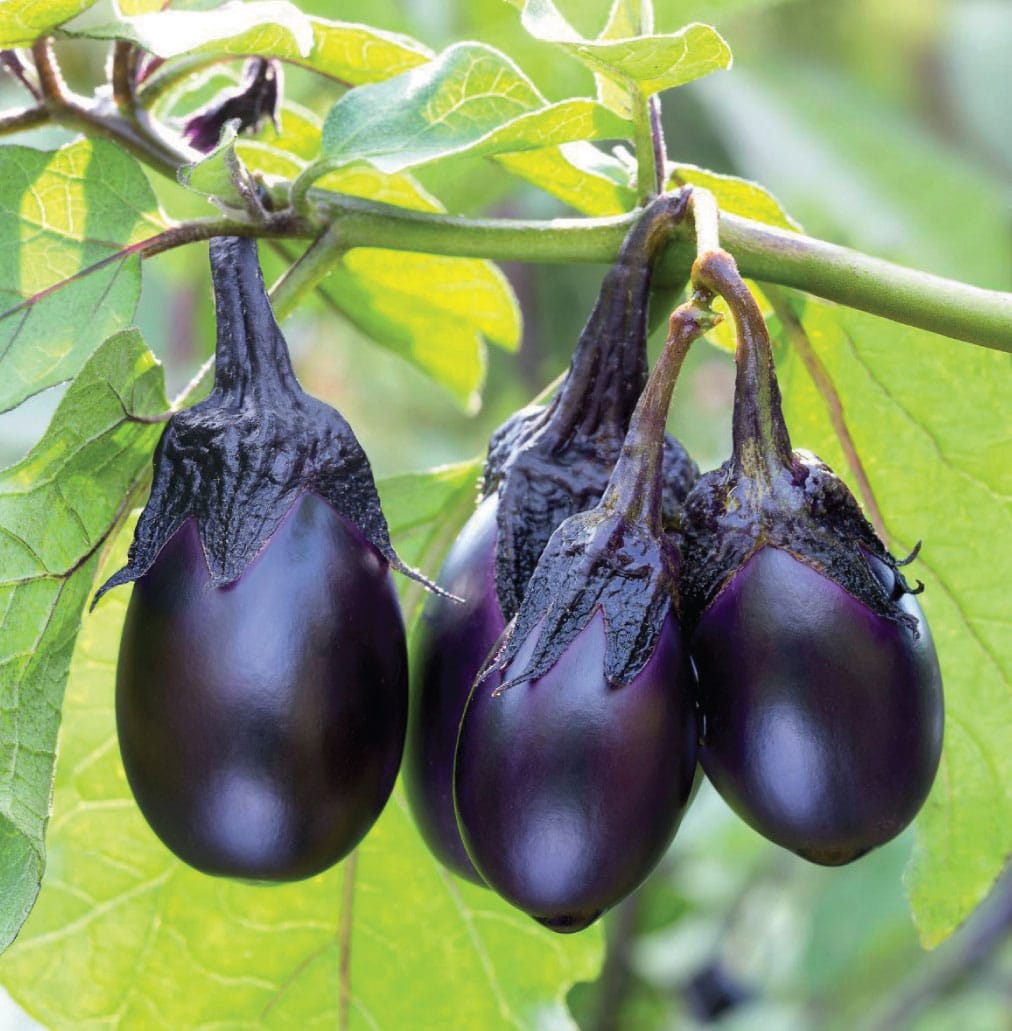
Little Gem Lettuce
COMMON NAME: Little Gem Lettuce
BOTANICAL NAME: Lactuca sativa var. longifolia ‘Little Gem’
MATURE DIMENSIONS: 8 to 10 inches tall; 6 inches wide
PHYSICAL APPEARANCE: ‘Little Gem’ is the cutest lettuce ever! It’s a very small Romaine-type lettuce with green, crunchy leaves and a super sweet flavor. Surprisingly heat tolerant, each plant makes one perfect little salad. The upright habit and firm head make this little beauty a true garden treasure.
PLANTING TIPS: ‘Little Gem’ is easy to grow by sowing the seeds directly into the garden in early spring or late summer. Sow more seeds every 2 weeks for a continual harvest. Plant the seeds 1/4 inch deep and 3 inches apart, then thin the seedlings to a spacing of 5 inches on center. Give summer sowings some shade to keep the plants from bolting and turning bitter.
CARE REQUIREMENTS: A variety that’s ready to harvest just 50 days after sowing the seeds, ‘Little Gem’ needs to be well watered, especially during warm weather. To harvest, cut the entire head off at the ground or snap off just a few outer leaves at a time for a cut-and-come-again harvest.
HARVEST TIME: Late spring through fall in the north, fall through spring in the south
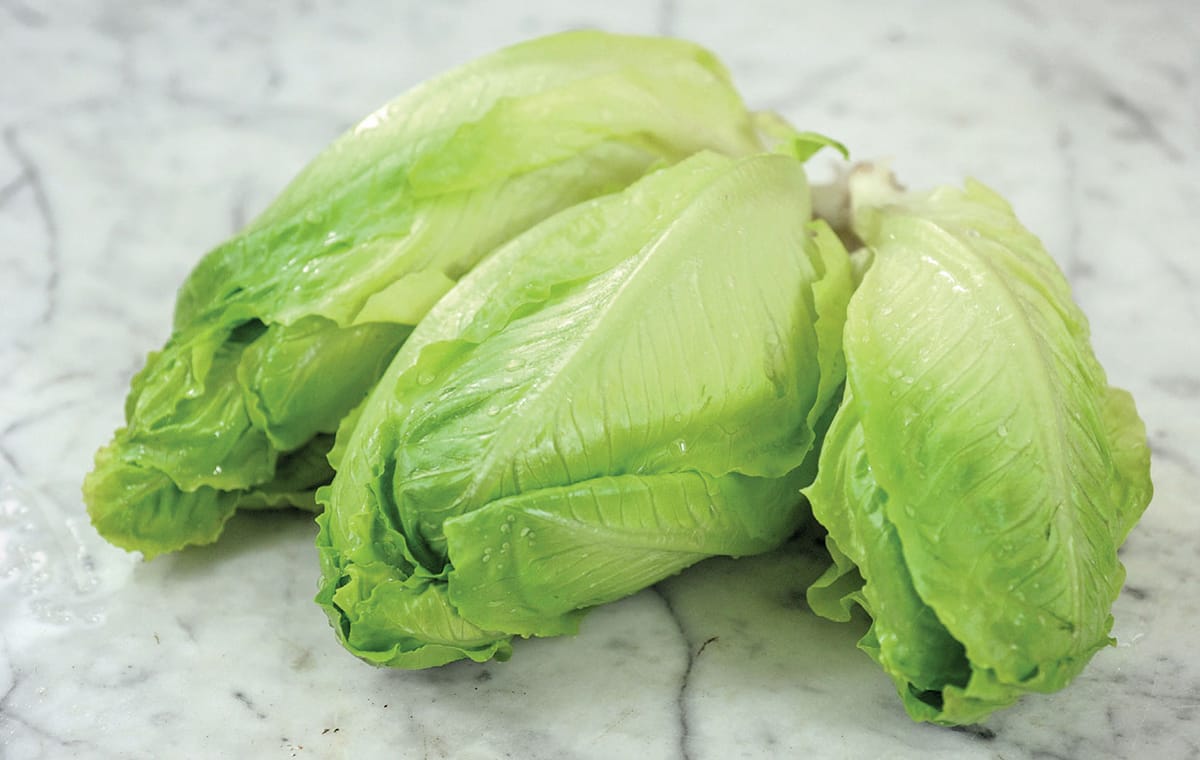
Dwarf Blue Curled Vates Kale
COMMON NAME: Dwarf Blue Curled Vates Kale
BOTANICAL NAME: Brassica oleracea ‘Dwarf Blue Curled’
MATURE DIMENSIONS: 12 inches tall; equally as wide
PHYSICAL APPEARANCE: This low-growing kale fills the garden with ruffled, bluish-green leaves. It’s cold tolerant and excellent when eaten cooked or raw. Kale is a cool-weather crop that’s best for spring or fall plantings. This is a seriously beautiful, curly leaved plant that is as ornamental as it is delicious.
PLANTING TIPS: ‘Dwarf Blue Curled’ kale is easiest to plant via direct sowing. Sow seeds 1/4 inch deep and 3 inches apart. Thin to an 8-inch spacing. This compact kale can be planted anytime in the spring as soon as the soil can be worked; about 2 to 4 weeks before the last expected frost is ideal. Late summer plantings result in fall and winter harvests. In warm southern regions, fall sowings are best.
CARE REQUIREMENTS: Ready to harvest just 55 days after planting from seed, ‘Dwarf Blue Curled’ is easy to protect from frosts with a layer of floating row cover, if you want to plant early or extend your fall harvest. Frost sweetens the flavor, so many gardeners relish late-season plantings. Harvest just the outer leaves and leave the growing point intact, or harvest the entire plant all at once.
HARVEST TIME: Late spring through early winter in the north; winter in the south

Pot of Gold Swiss Chard
COMMON NAME: Pot of Gold Swiss Chard
BOTANICAL NAME: Beta vulgaris subsp. vulgaris ‘Pot of Gold’
MATURE DIMENSIONS: 12 to 15 inches tall; 8 to 10 inches wide
PHYSICAL APPEARANCE: Beautiful golden yellow stems and thick, succulent, green leaves make ‘Pot of Gold’ swiss chard a real superstar. Among the most reliable crops, chard is easy to grow, striking to look at, and flavorful in the kitchen. The lush, vase-shaped plants look great in gardens and containers.
PLANTING TIPS: Chard is best planted from seed sown directly into the garden or container anytime from early spring through late summer. Southern gardeners can grow it all winter long. If you’re growing chard in a pot, choose a deep container. Sow seeds 1/2 inch deep and 1 inch apart, then thin the seedlings to 8 to 10 inches as they mature. Baby greens can be used in salads in as little as 30 days, while mature leaves take about 50 days from seed.
CARE REQUIREMENTS: Highly frost tolerant, chard is one of the easiest early-season crops to grow. But, keep the bunnies and deer away from the plants, as they seem to enjoy chard as much as people do! Harvest the outermost leaves on a regular basis, and leave the growing point intact for a continuous harvest. Cover the plants with a floating row cover for an extended harvest through the fall and early winter.
HARVEST TIME: Spring through summer in the north; fall through spring in the south

Extra Dwarf Pak Choy (Pak Choi/Bok Choy)
COMMON NAME: Extra Dwarf Pak Choy (Pak Choi/Bok Choy)
BOTANICAL NAME: Brassica rapa subsp. chinensis ‘Extra Dwarf’
MATURE DIMENSIONS: 2 to 3 inches tall; equal spread
PHYSICAL APPEARANCE: ‘Extra Dwarf’ pak choy is about the most adorable veggie you can grow! Picked when it’s just 2 to 3 inches tall, the deep green leaves, crisp midribs, and thick, white petioles (leaf stems) are excellent stir-fried or sautéed. The compact heads of this Asian green are fast to mature in just 30 days from seed.
PLANTING TIPS: To plant, sow seeds out in the garden 1/4 inch deep and 1 inch apart. Thin to a spacing of 4 inches on center. This cool-season plant is best planted very early or very late in the season to avoid bolting. It does not tolerate heat and resents transplanting. Warm-climate gardeners can grow this pak choy all winter long.
CARE REQUIREMENTS: Keep seed bed evenly moist, and protect early and late plantings with a layer of floating row cover. Harvest the entire head by cutting it off at ground level.
HARVEST TIME: Mid- to late spring in the north; fall to early spring in the south

Little Hero Spinach
COMMON NAME: Little Hero Spinach
BOTANICAL NAME: Spinacia oleracea ‘Little Hero’
MATURE DIMENSIONS: 2 inches tall; 5 inches wide
PHYSICAL APPEARANCE: The short, dark green, crunchy leaves of ‘Little Hero’ spinach are best picked baby sized. Its nutty flavor and succulent texture make this compact spinach a real winner. Plus, it’s fast growing, maturing in just 40 days from seed.
PLANTING TIPS: Spinach is a cool-season crop. Plant seeds in the very early spring for spring harvests; or plant in the fall for fall and a subsequent spring harvest. In all but the extreme north, the plants readily overwinter when seeds are sown in the fall. In the south, ‘Little Hero’ can be grown all winter long. To plant, sow seeds 1/2 inch deep and 2 inches apart. Then, thin to a 6-inch spacing. Another option is to sow the seeds thickly and grow a solid bed of baby greens for scissor harvest.
CARE REQUIREMENTS: It’s important to keep the seedbed well watered prior to germination. Multiple harvests can be made from the same planting as long as the growing points are left intact. Eventually, the plants will bolt when the weather gets hot and the days grow long. When this happens, pull up the plants.
HARVEST TIME: Mid-spring or fall in the north; fall through spring in the south

Long Island Semidwarf Brussels Sprouts
COMMON NAME: Long Island Semidwarf Brussels Sprouts
BOTANICAL NAME: Brassica oleracea var. gemmifera ‘Long Island’
MATURE DIMENSIONS: 20 to 24 inches tall; 12 inches wide
PHYSICAL APPEARANCE: An heirloom brussels sprout that produces tons of mini cabbage-like sprouts all along the stem, ‘Long Island’ is an old variety that was once a staple garden crop. It has leaves that are tightly spaced, and each node produces a single sprout. Since the plants are compact and very upright, the stems do not need to be supported. This semidwarf brussels sprout variety is one-third to one-half the height of full-sized varieties.
PLANTING TIPS: Start seeds indoors under grow lights in late winter, about 10 weeks prior to your last expected frost date. The cold-tolerant transplants can move out into the garden as soon as the soil can be worked in the early spring. Seeds can also be sown directly into the garden in spring but must be thinned to a spacing of 15 inches.
CARE REQUIREMENTS: ‘Long Island’ takes about 90 to 100 days to reach maturity, so it requires a long growing season. Spring plantings aren’t harvested until the autumn. In the south, brussels sprouts are a winter crop. Harvest the sprouts after a frost, which sweetens their flavor. To pick, twist or cut the sprouts off the stem. Sprouts can be harvested just a handful at a time or all at once.
HARVEST TIME: Fall in the north; spring in the south
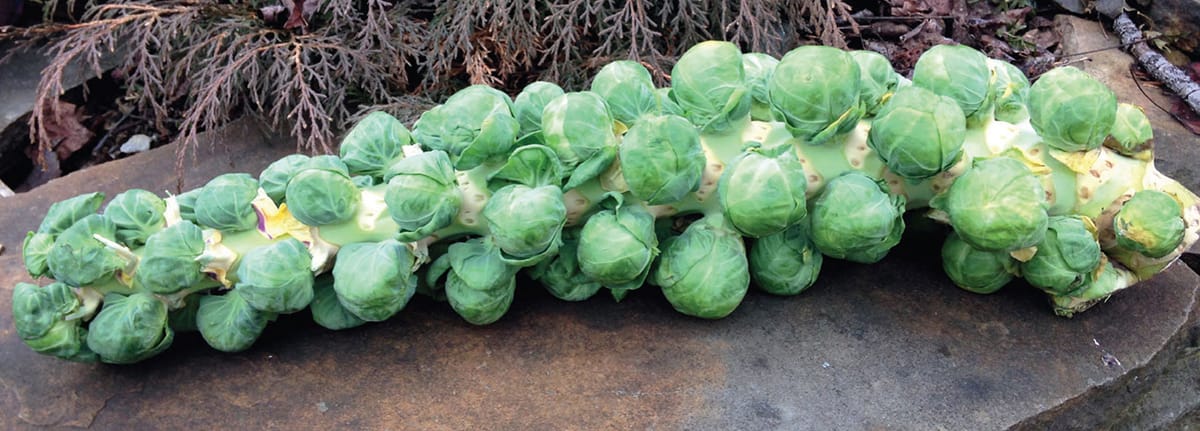
Baby Bubba Okra
COMMON NAME: Baby Bubba Okra
BOTANICAL NAME: Abelmoschus esculentus ‘Baby Bubba’
MATURE DIMENSIONS: 3 to 4 feet tall; 1 foot wide
PHYSICAL APPEARANCE: Okra is typically a large plant with a deep tap root, but this hybrid dwarf variety is only half as tall as standard okra and its root system is far less aggressive. A prolific producer of 2- to 3-inch-long, green pods, ‘Baby Bubba’ has lush green leaves with red stems and white flowers that are centered with a splash of red.
PLANTING TIPS: Ready for harvest in just 53 days, seeds are best sown directly into the garden after the danger of frost has passed and the soil has warmed. Plant seeds 1 inch deep and 10 inches apart. Or, start seeds indoors under grow lights 6 weeks before your average frost-free date and move the transplants outdoors after frosts end. You can also grow one plant per 2-gallon container. This variety is early to bear compared to other okras, making it great for both the north and the south.
CARE REQUIREMENTS: Mulch the plants with straw or shredded leaves to keep the roots cool and moist, and limit weeds. Harvest the pods by cutting them from the stems every few days to encourage further production.
HARVEST TIME: Summer through fall
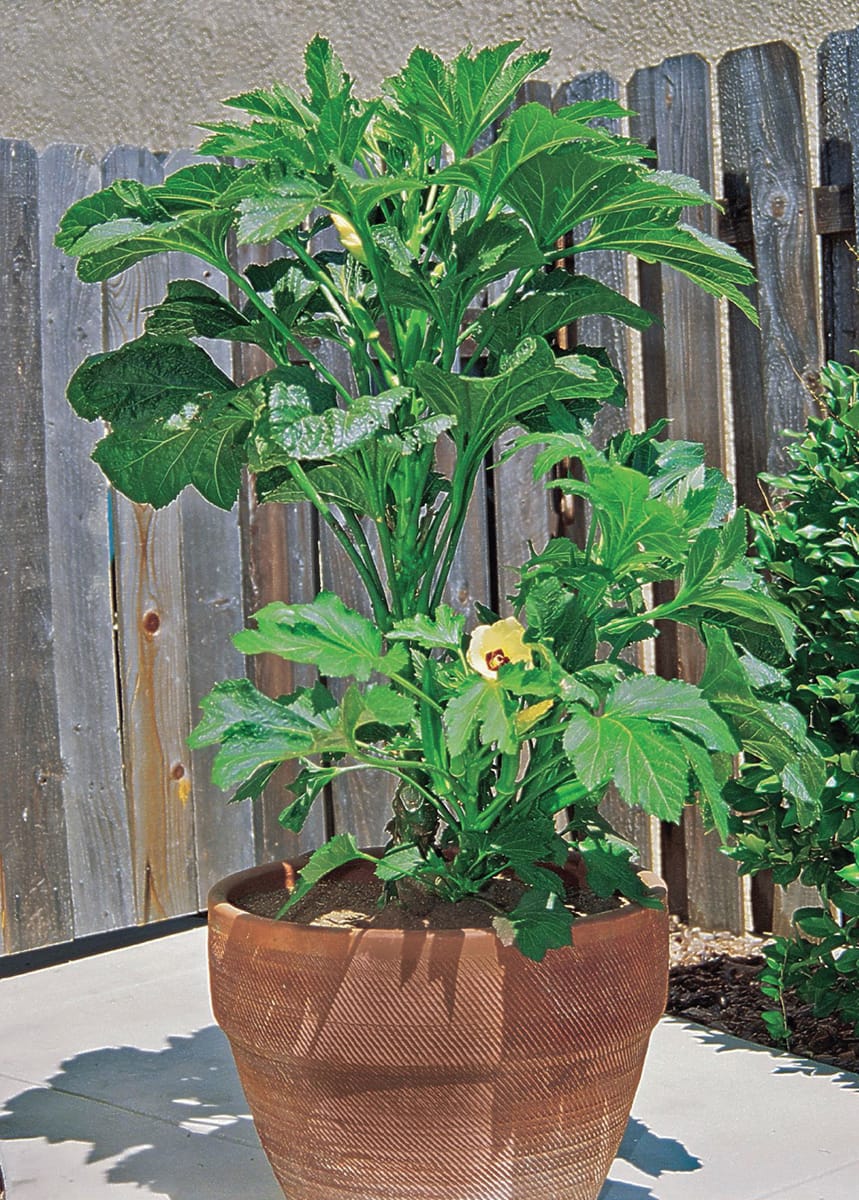
Mohawk Patio Peppers
COMMON NAME: Mohawk Patio Peppers
BOTANICAL NAME: Capsicum annuum ‘Mohawk’
MATURE DIMENSIONS: 8 to 10 inches tall; 10 to 12 inches wide
PHYSICAL APPEARANCE: Compact plants with 4-inch-long, thick-walled fruits that start green and ripen to a rich orange, ‘Mohawk’ is a very productive compact variety. The peppers are shaped like an elongated bell, and the plants are highly branched.
PLANTING TIPS: It takes this hybrid selection 75 days to reach maturity. ‘Mohawk’ looks great in hanging baskets and containers as well as in the garden. Sow seeds indoors under grow lights 8 weeks before the last spring frost, then transplant outdoors after the danger of frost has passed. Space the plants 18 inches apart in the garden or plant one transplant per 3-gallon container.
CARE REQUIREMENTS: Choose a well-drained area high in organic matter for planting. Like other peppers, ‘Mohawk’ may drop blossoms when temperatures are very hot. Its slightly trailing habit means there’s no need to stake; just let the plants tumble.
HARVEST TIME: Summer through fall
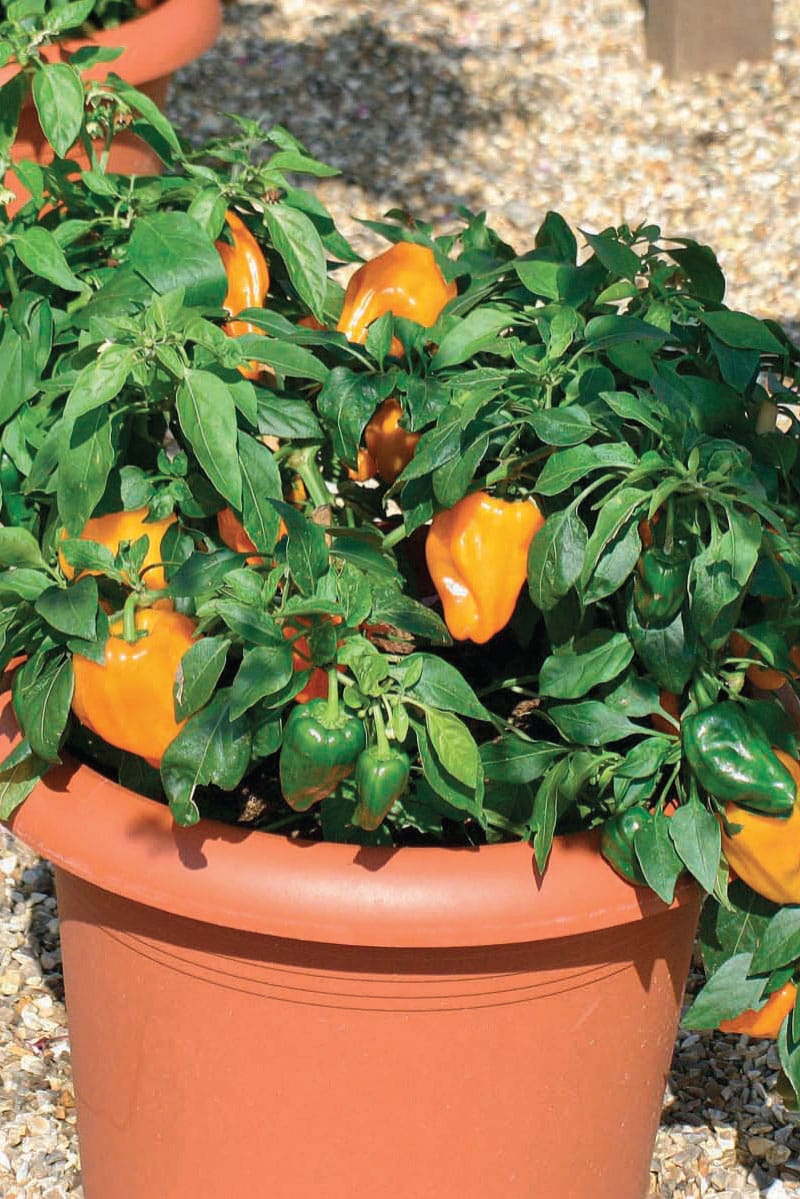
Pizza My Heart Peppers
COMMON NAME: Pizza My Heart Peppers
BOTANICAL NAME: Capsicum annuum ‘Pizza My Heart’
MATURE DIMENSIONS: 2 to 3 feet tall; 12 to 18 inches wide
PHYSICAL APPEARANCE: These conical peppers ripen to a glossy, brilliant red and their flavor is supreme. Very prolific and early to produce, ‘Pizza My Heart’ peppers have a slight heat.
PLANTING TIPS: Sow seeds indoors under grow lights 8 weeks before the last expected frost. Seeds may take up to 4 weeks to germinate. When nighttime temps reach 55°F consistently, move the plants into the garden, spacing them 18 inches apart or planting one transplant per 3-gallon pot.
CARE REQUIREMENTS: Requires 80 days from transplant to harvest, and staking or caging may be necessary when branches are laden with fruits. Mulch the plants to keep the soil moist and avoid blossom end rot. Harvest the peppers when they’re fully colored by cutting them from the plant.
HARVEST TIME: Summer through fall
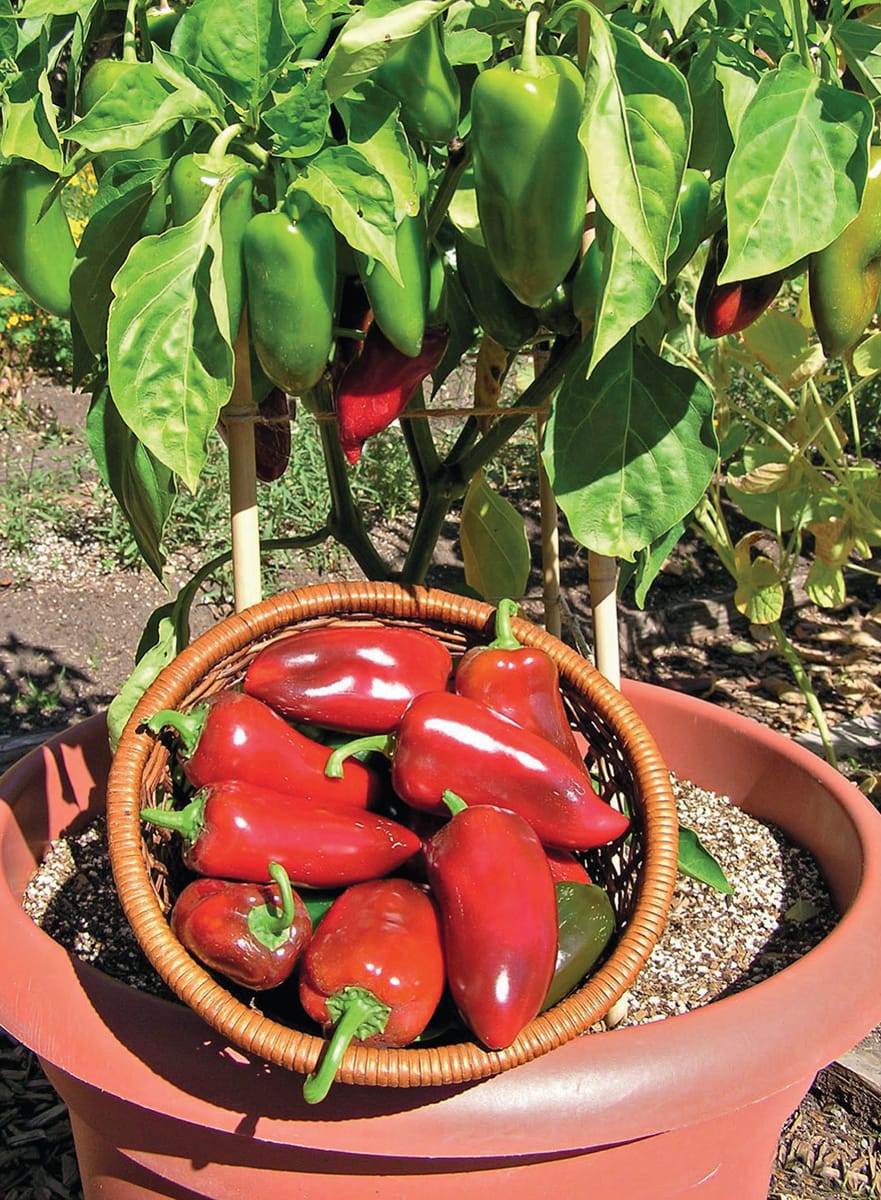
Tom Thumb Popcorn
COMMON NAME: Tom Thumb Popcorn
BOTANICAL NAME: Zea mays var. everta ‘Tom Thumb’
MATURE DIMENSIONS: 3 to 4 feet tall; 18 inches wide
PHYSICAL APPEARANCE: This crazy little popcorn is half the height of full-sized popcorn varieties but surprisingly productive, making it a great choice for backyard gardeners. It produces one or two 4-inch-long ears per stalk, and its quick maturity (85 days) makes it great for short-season areas. ‘Tom Thumb’ yields yellow kernels that are popped into flavorful popcorn.
PLANTING TIPS: To grow this dwarf popcorn, plant seeds 1 inch deep and 4 inches apart in rows spaced 2 feet apart. You’ll need a block of plants for good pollination and ear production rather than a single long row. If you grow ‘Tom Thumb’ in containers, make sure you have several dozen plants to ensure there’s ample pollen in the air. Wait to plant the seeds until soil has warmed to 65°F and frost no longer threatens.
CARE REQUIREMENTS: An old variety from the mid-1800s, these dwarf plants are great for even cold climates, but do not plant ‘Tom Thumb’ near other varieties of corn to avoid cross-pollination and poor quality (a 500-foot separation is best). Allow the cobs to fully dry on the stalks before harvest, then lay the husked ears on a piece of newspaper in a dry room for a month before storing the cobs or loose kernels in an airtight container prior to popping.
HARVEST TIME: Late summer
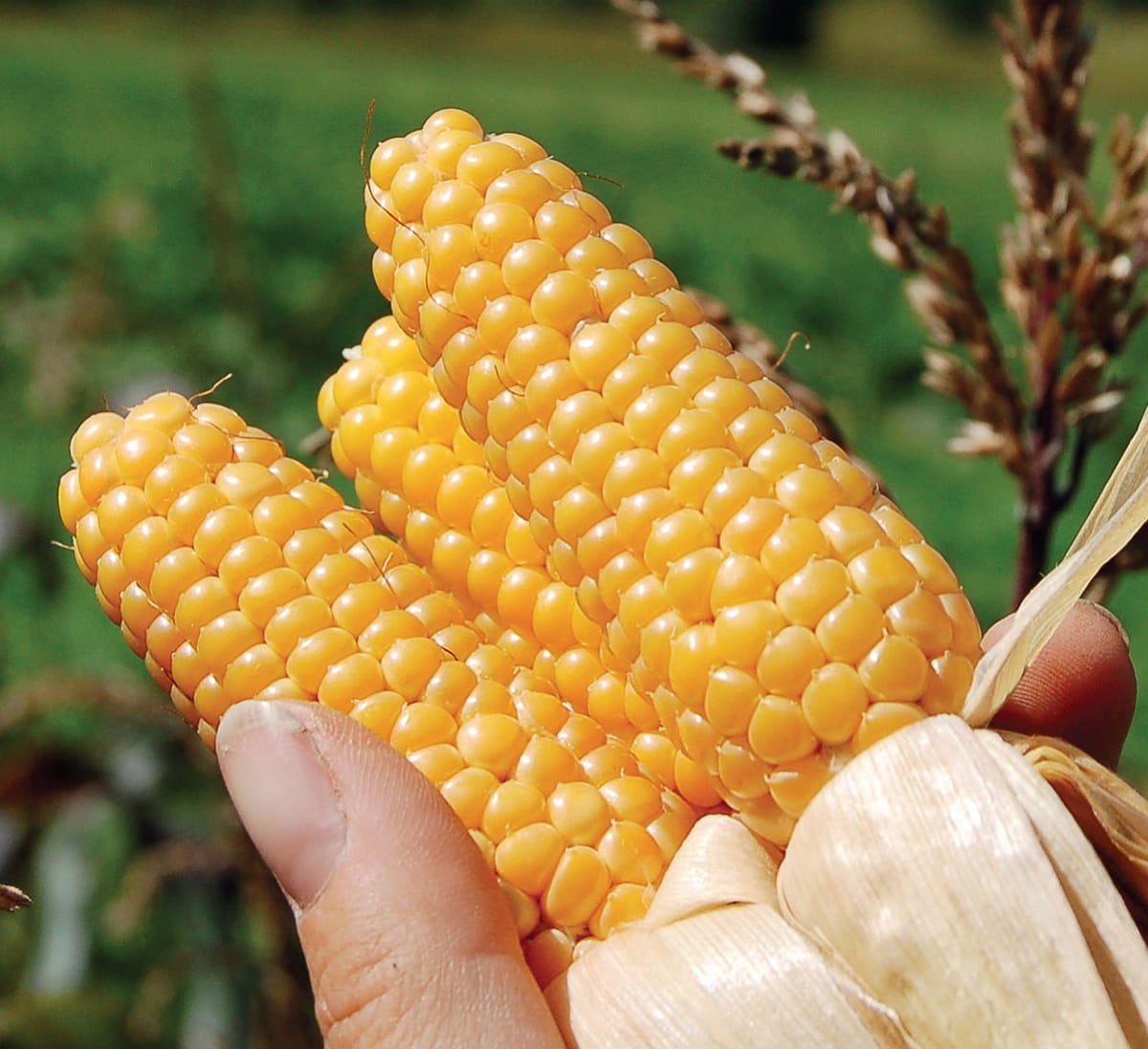
Orange Cutie Pumpkins
COMMON NAME: Orange Cutie Pumpkins
BOTANICAL NAME: Cucurbita maxima ‘Orange Cutie’
MATURE DIMENSIONS: 12 to 18 inches tall; 6 to 7 feet wide
PHYSICAL APPEARANCE: Pumpkin vines are notorious for taking over the garden, but this semibush hybrid variety has vines that are only one-third as long as standard pumpkin vines. Each ‘Orange Cutie’ plant produces 8 to 10 fruits that are orange with paler orange streaks on the midribs. Measuring 6 inches across and 5 inches tall, the pumpkins are great for both decoration and eating.
PLANTING TIPS: ‘Orange Cutie’ requires 100 days from seed. To plant, sow seeds 1 inch deep directly into garden when the soil temperature reaches 65°F and no frost threatens. Space the plants 3 to 4 feet apart or plant one vine per 5-gallon container.
CARE REQUIREMENTS: Good pollination is essential for pumpkin production. Like other varieties, the male flowers open first and have straight stems, while female flowers open later and have a mini-pumpkin at their base. Plant plenty of flowers near the vines to ensure lots of pollinators are around. Provide plants with consistent moisture, and leave the fruits on the vine until they’re fully colored.
HARVEST TIME: Fall
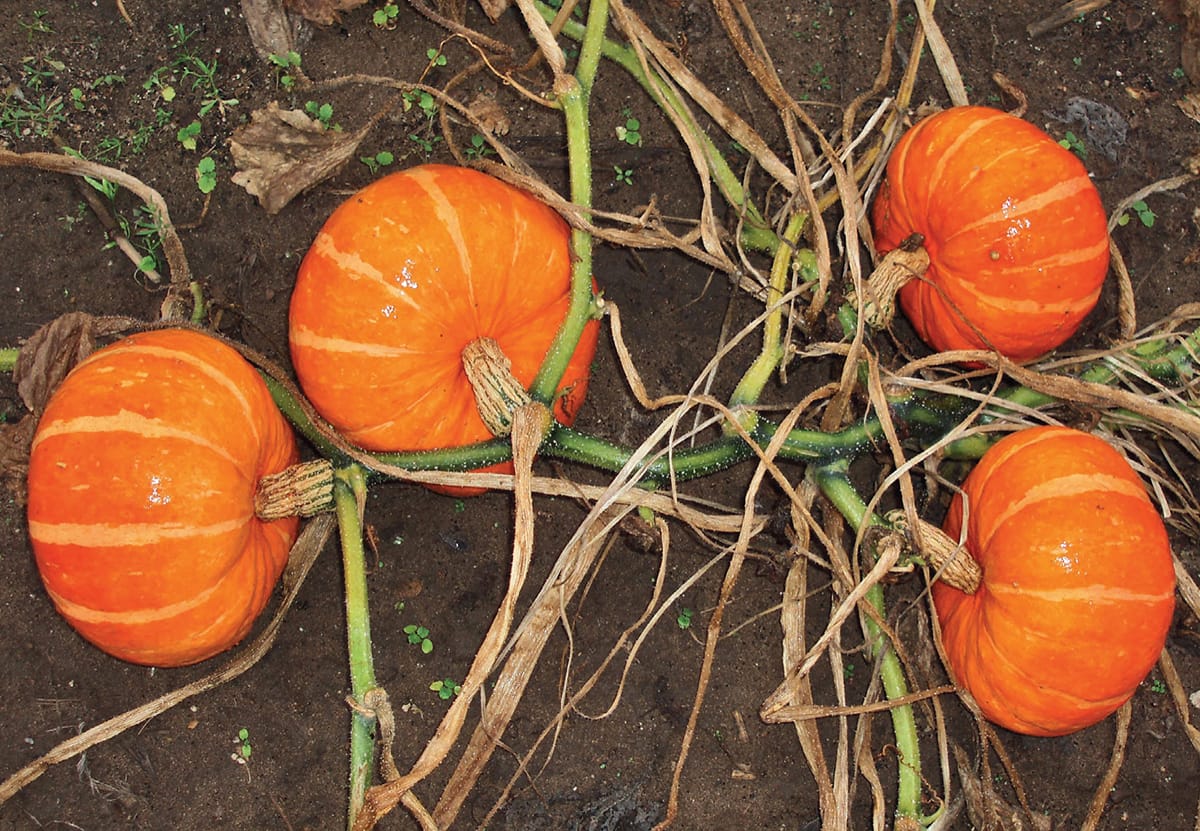
Astia Zucchini
COMMON NAME: Astia Zucchini
BOTANICAL NAME: Cucurbita pepo ‘Astia’
MATURE DIMENSIONS: 18 inches tall; 2 to 21/2 feet wide
PHYSICAL APPEARANCE: A favorite zucchini of container gardeners, ‘Astia’s’ deep, glossy green fruits are best picked when 6 to 7 inches long. The plants are only half the width of other varieties, and their open habit makes harvesting a snap. ‘Astia’ is resistant to powdery mildew and produces very early (just 38 to 42 days after planting!).
PLANTING TIPS: This compact, hybrid zucchini is best started by sowing the seeds directly into the garden or container when the threat of frost has passed and summer weather has arrived. Plant the seeds 1 inch deep and 3 feet apart, or plant one plant per 5- to 8-gallon container.
CARE REQUIREMENTS: As with other squash, good pollination is key for ample fruit set. If your zucchini have misshapen ends or fail to grow, it’s a sure sign of poor pollination. Plant this variety alongside flowers to increase the number of pollinating insects present. Harvest by cutting the fruits from the vine; do not pull. Harvest on a daily basis to ensure continual zucchini production.
HARVEST TIME: Summer through fall
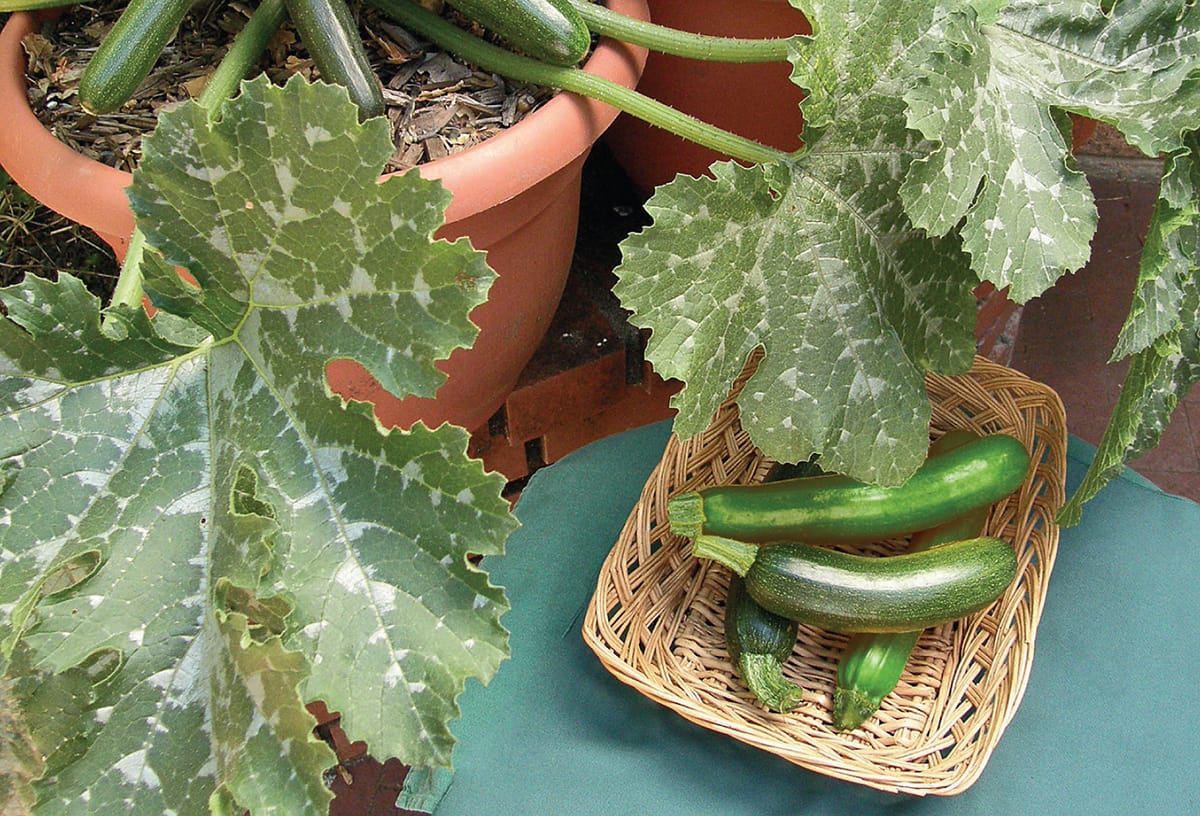
Patio Star Zucchini
COMMON NAME: Patio Star Zucchini
BOTANICAL NAME: Cucurbita pepo ‘Patio Star’
MATURE DIMENSIONS: 18 inches tall; 2 feet wide
PHYSICAL APPEARANCE: A patio-perfect zucchini if there ever was one! The dark green, shiny fruit is thin skinned and flavorful. With green leaves edged in white and a prolific production rate, ‘Patio Star’ is indeed a star of the patio. Plants mature in 50 days from seed. This hybrid is half the size of standard plants.
PLANTING TIPS: To plant, sow the seeds directly into the garden 1 inch deep and 3 feet apart or plant one plant per 5- to 8-gallon container. Since zucchini plants are frost sensitive, wait to plant until frost no longer threatens. For continuous harvests, sow a few new seeds every few weeks.
CARE REQUIREMENTS: For the best production, keep the soil evenly moist throughout the plant’s growth cycle. Harvest by cutting the fruit from vine; do not pull. If you have poor fruit set or the zucchinis are misshapen, poor pollination may be a factor.
HARVEST TIME: Summer through fall
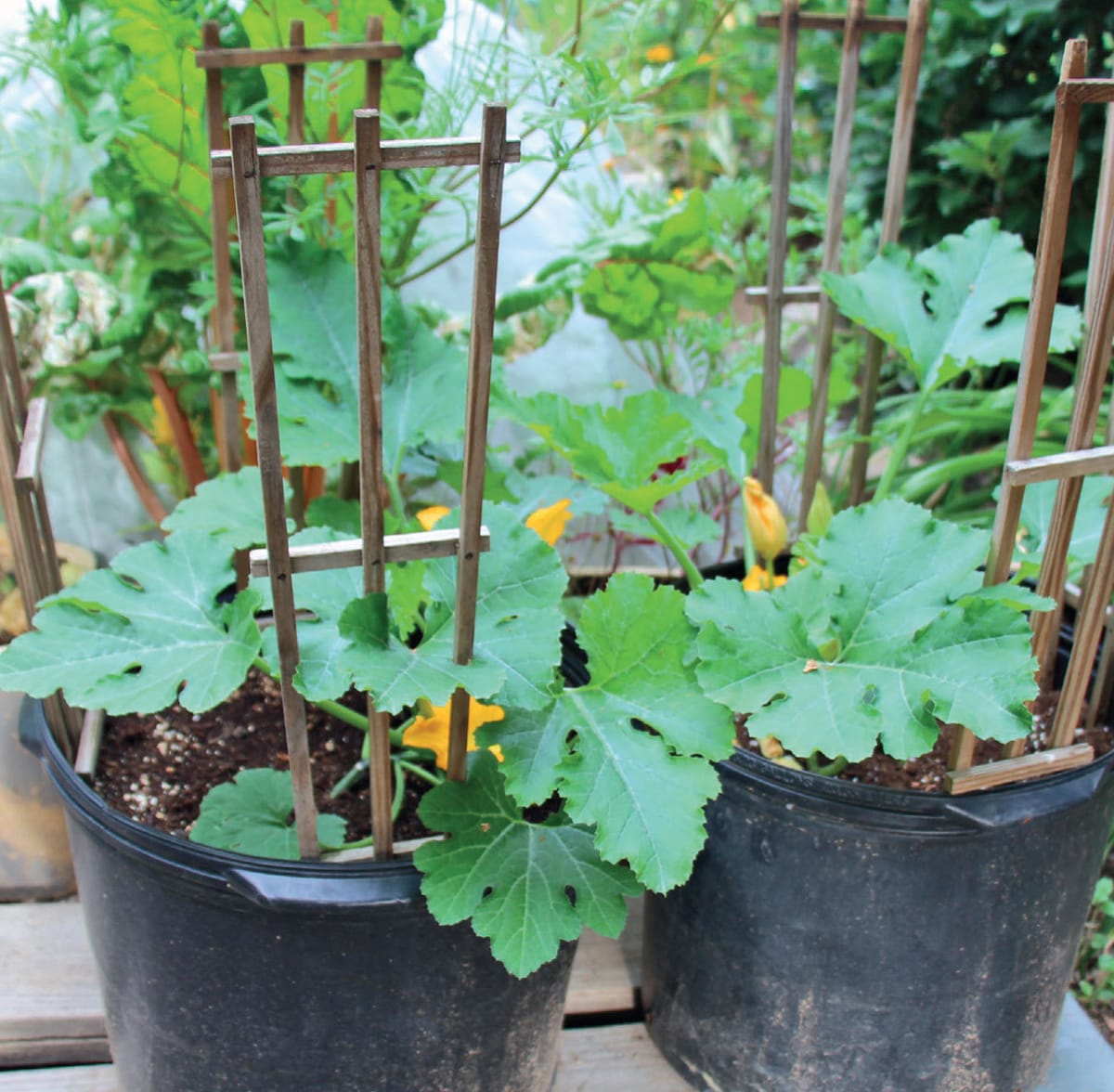
Honey Bear Winter Squash
COMMON NAME: Honey Bear Winter Squash
BOTANICAL NAME: Cucurbita pepo ‘Honey Bear’
MATURE DIMENSIONS: 2 feet tall; 4 feet wide
PHYSICAL APPEARANCE: This gorgeous hybrid acorn squash has a rind that’s deep green and flesh that’s rich orange. Each fruit weighs 1 to 11/4 pounds. The compact bush plants do not vine and take over the garden, and they’re resistant to powdery mildew. Expect each plant to produce three to four fruits. At half the size of a standard variety, this heavy-yielding winter squash is a true award winner.
PLANTING TIPS: It’s best to wait until after the danger of frost has passed to sow seeds directly in the garden. You can also start seeds indoors under grow lights about 4 weeks prior to your last frost date, if you live where the growing season is short. When starting plants indoors, try not to disturb the roots when transplanting them out into the garden. Seeds should be sown 1 inch deep and spaced 3 feet apart, or plant one plant per 8- to 10-gallon container. ‘Honey Bear’ requires 100 days from seed to reach maturity
CARE REQUIREMENTS: Mulch winter squash with several inches of straw or shredded leaves to retain soil moisture and limit weeds. Allow the fruits to ripen on the vine until a yellow spot appears on the bottom side of the fruit where it touches the soil, about 55 days after the plants come into flower.
HARVEST TIME: Late summer through fall
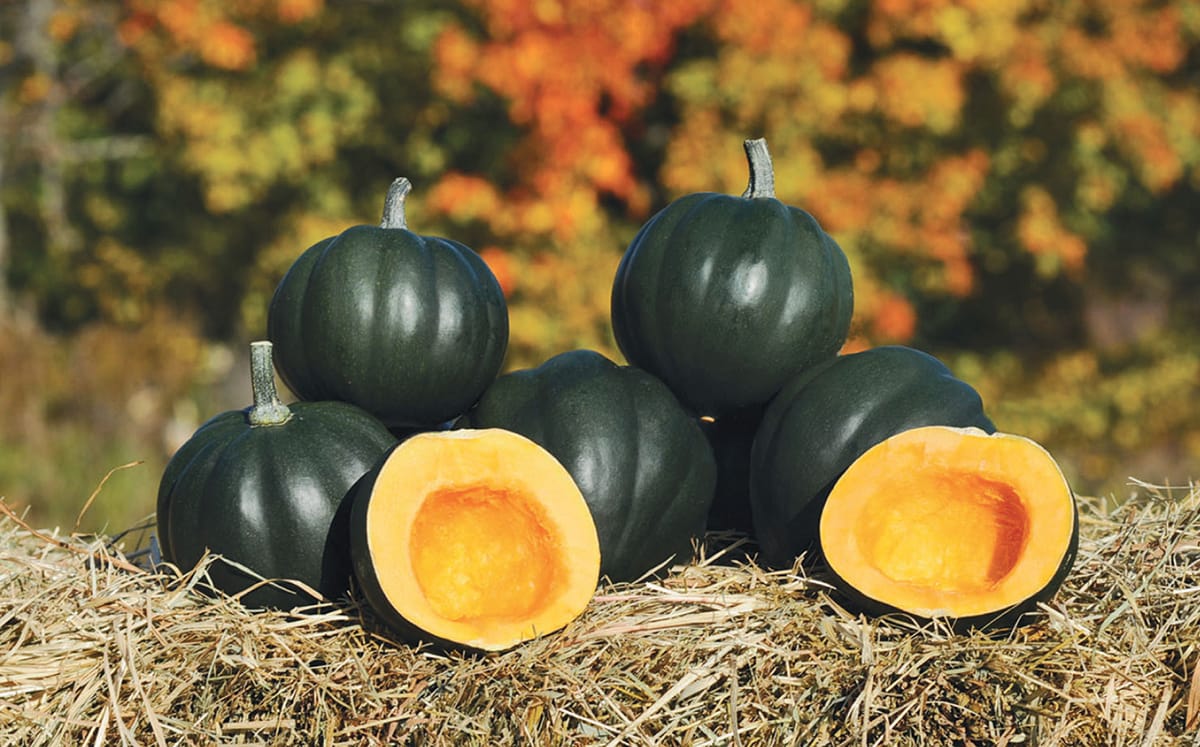
Sugarbush Winter Squash
COMMON NAME: Sugarbush Winter Squash
BOTANICAL NAME: Cucurbita pepo ‘Sugarbush’
MATURE DIMENSIONS: 2 feet tall; 4 to 5 feet wide
PHYSICAL APPEARANCE: ‘Sugarbush’ is an acorn-type winter squash with dark-skinned fruits and deep orange flesh. The compact, bushy plants are resistant to powdery mildew and ready to harvest about 90 days after planting. The 21/2-pound fruits are sweet with an excellent texture.
PLANTING TIPS: If you live where the growing season is short, plant seeds indoors under grow lights about 4 weeks before your last expected spring frost. Move the plants outdoors when the weather warms. If you live where summers are long and warm, sow the seeds directly into the garden after the threat of frost has passed. Plant seeds 1 inch deep and 3 feet apart, or plant one plant per 8 to 10 gallon container.
CARE REQUIREMENTS: Harvest the squash when their rinds are hard and they have an orange patch on the bottom where they touch the ground. Leave a short stem on the squash when cutting them from the vine.
HARVEST TIME: Late summer through fall
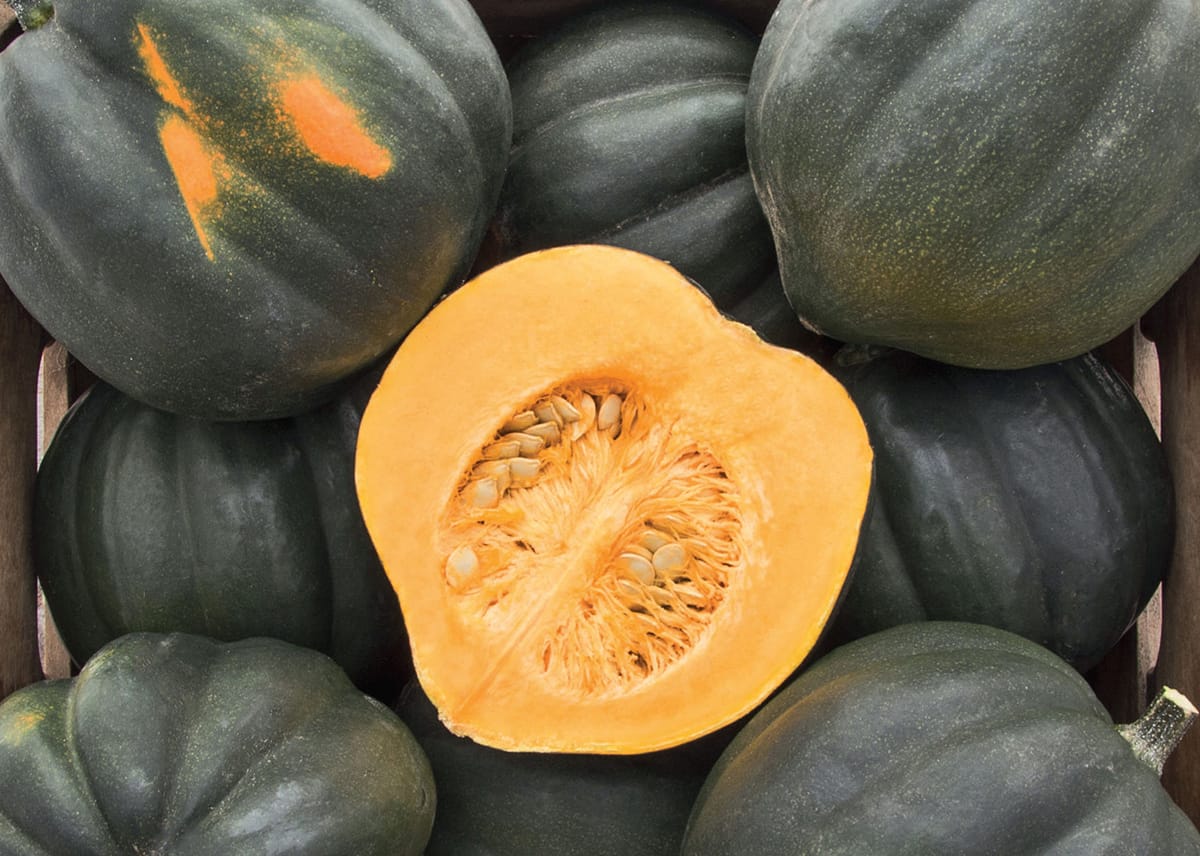
Totem Tomato
COMMON NAME: Totem Tomato
BOTANICAL NAME: Solanum lycopersicum ‘Totem’
MATURE DIMENSIONS: 18 to 30 inches tall; 18 inches wide
PHYSICAL APPEARANCE: A compact and highly productive tomato, ‘Totem’ is ready to harvest just 70 days from transplant. It bears tons of 1- to 2-inch, bright red fruit in large clusters on beefy little plants. The foliage is lush and beautiful, making this variety great for front porch pots and deck planters.
PLANTING TIPS: Sow the seeds indoors under grow lights about 6 weeks before the average last frost date. Then, transplant the seedlings outside after the danger of frost has passed. Like other tomatoes, bury the plants deeply to encourage the development of an extensive root system. Space plants 3 feet apart, or put one plant per 3- to 5-gallon pot.
CARE REQUIREMENTS: Provide consistent moisture to avoid blossom end rot, especially when growing ‘Totem’ in a container. Mulching the plants helps keep the soil evenly moist, too. The short and stocky growth habit of this variety means no staking is required.
HARVEST TIME: Summer through fall
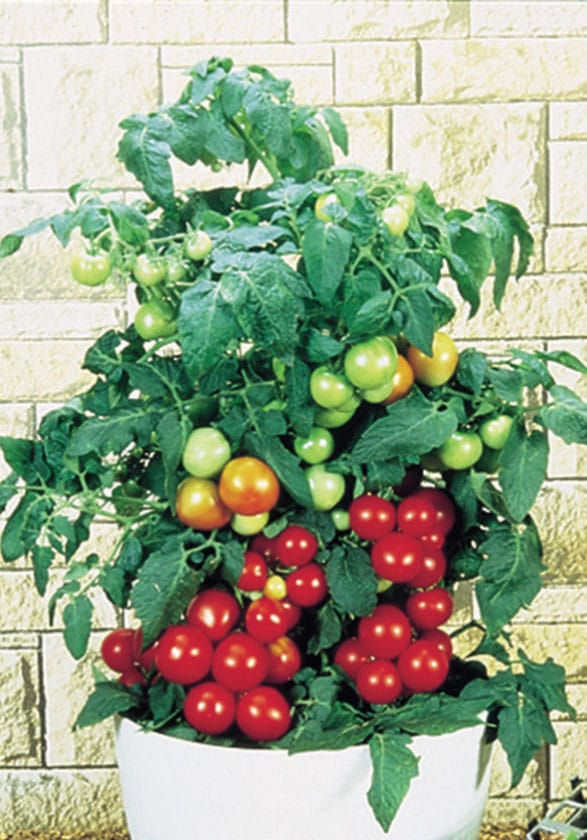
Super Bush Tomato
COMMON NAME: Super Bush Tomato
BOTANICAL NAME: Solanum lycopersicum ‘Super Bush’
MATURE DIMENSIONS: 2 to 3 feet tall; 1 to 2 feet wide
PHYSICAL APPEARANCE: These saladette tomatoes weigh in at 5 to 6 ounces each and fit nicely in the palm of your hand. Their sweet flavor is ready to enjoy about 70 days after the transplants are settled into the garden. A hybrid variety with high yields, the dark green foliage is very attractive.
PLANTING TIPS: Sow seeds of ‘Super Bush’ indoors under grow lights about 6 weeks before the last expected spring frost. Move the seedlings into the garden when frost no longer threatens. Space the plants 3 to 4 feet apart, or put one plant per 5- to 8-gallon container. Bury the plants deeply to encourage good root growth, and mulch well with straw or shredded leaves to optimize the soil’s moisture retention.
CARE REQUIREMENTS: Due to the heavy production of this plant, use a tomato cage or staking system to keep the vines upright. Regularly prune excessive leaf growth to encourage tomato production.
HARVEST TIME: Summer through fall
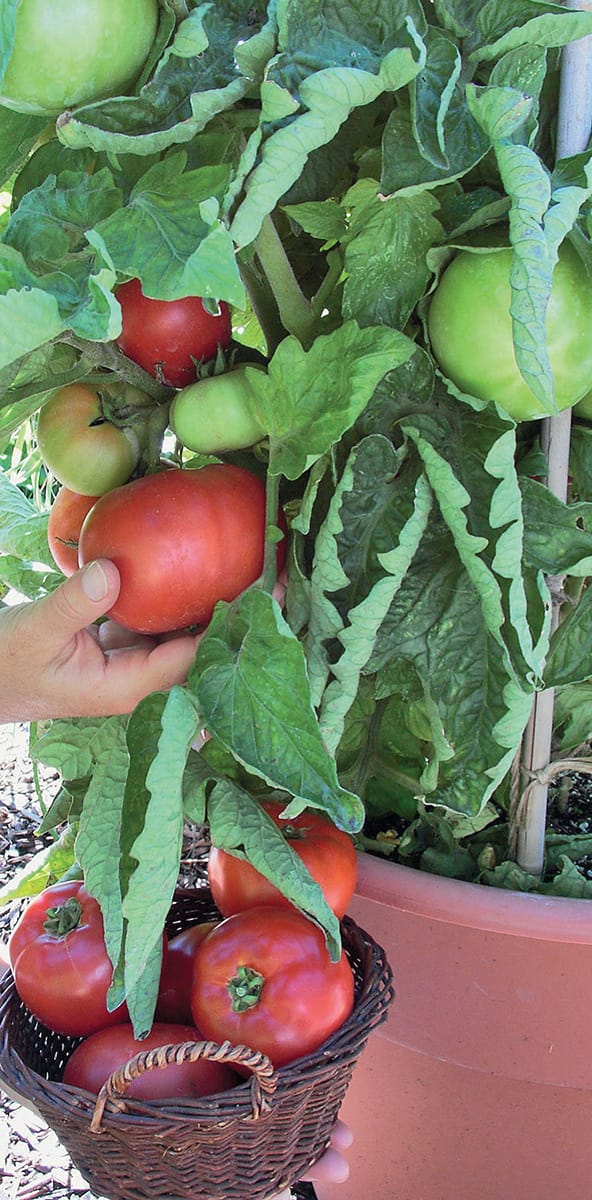
Bush Goliath Tomato
COMMON NAME: Bush Goliath Tomato
BOTANICAL NAME: Solanum lycopersicum ‘Bush Goliath’
MATURE DIMENSIONS: 3 feet tall; 11/2 feet wide
PHYSICAL APPEARANCE: This variety is always a surprise! Good-sized, 6- to 8-ounce fruits measure 3 to 4 inches wide and are incredibly prolific. Their bright red coloration is perfectly consistent, and the flavor is delish! Ready to pick 68 days from transplant, these determined vines produce clusters of fruit all summer long.
PLANTING TIPS: Sow seeds indoors under grow lights 6 weeks before moving the transplants outdoors. Bury the stems deeply when planting, allowing just the top few leaves to stick above the soil line. If you’re growing ‘Bush Goliath’ in a pot, one that’s between 8 and 10 gallons is ideal. Or, space the plants 3 to 4 feet apart in the garden.
CARE REQUIREMENTS: Keep the soil consistently moist to avoid blossom end rot. Mulch the plants with 2 to 3 inches of straw or shredded leaves. Provide a tomato cage or stake to support the fruit-laden stems, especially as the season progresses.
HARVEST TIME: Summer through fall

Red Profusion Tomato
COMMON NAME: Red Profusion Tomato
BOTANICAL NAME: Solanum lycopersicum ‘Red Profusion’
MATURE DIMENSIONS: 6 inches tall; 2 feet wide
PHYSICAL APPEARANCE: ‘Red Profusion’ is an exceptional choice for pots and hanging baskets. The trailing vines of this hybrid form a mound and produce fruits that are 1 inch across, deep red, and intensely flavorful. The highly branched growth habit of this selection looks great tumbling over the edge of a raised planter or garden container.
PLANTING TIPS: These compact plants are best for containers due to their sprawling growth habit. Fast production (just 47 days after transplanting!) means you’ll have an early and prolific harvest. Start the seeds indoors under grow lights 6 weeks before the danger of frost passes. Plant one transplant per large hanging basket or 2- to 3-gallon pot.
CARE REQUIREMENTS: Ensure each plant receives consistent and regular irrigation. Containerized tomatoes are prone to blossom end rot and keeping them properly watered prevents this disorder. Harvest ripe tomatoes on a continual basis to encourage more blooms and subsequent fruits.
HARVEST TIME: Summer through fall

Tumbling Tom Tomato
COMMON NAME: Tumbling Tom Tomato
BOTANICAL NAME: Solanum lycopersicum ‘Tumbling Tom’
MATURE DIMENSIONS: 6 to 8 inches tall; 12 inches wide
PHYSICAL APPEARANCE: The short, cascading vines of ‘Tumbling Tom’ make this variety the quintessential choice for containers of all types. Red or yellow cherry-type tomatoes are produced prolifically 65 to 70 days after transplant. These little cuties look so pretty in window boxes, hanging baskets, and vertical gardens of any shape and size.
PLANTING TIPS: Sow seeds of ‘Tumbling Tom’ indoors under grow lights 6 weeks before the danger of frost passes. In spring, when frost no longer threatens, plant the transplants outdoors by sinking their stems deeply into the ground. This encourages good root production on all types of tomatoes. Plant one vine per 2- to 3-gallon container.
CARE REQUIREMENTS: There’s no need to stake ‘Tumbling Tom’ plants due to their rambling growth habit, but it’s best to grow this selection in a pot and not in the ground. Pick the tomatoes as soon as they’re ripe to encourage further production. Water regularly and give the plants maximum sunlight.
HARVEST TIME: Summer through fall
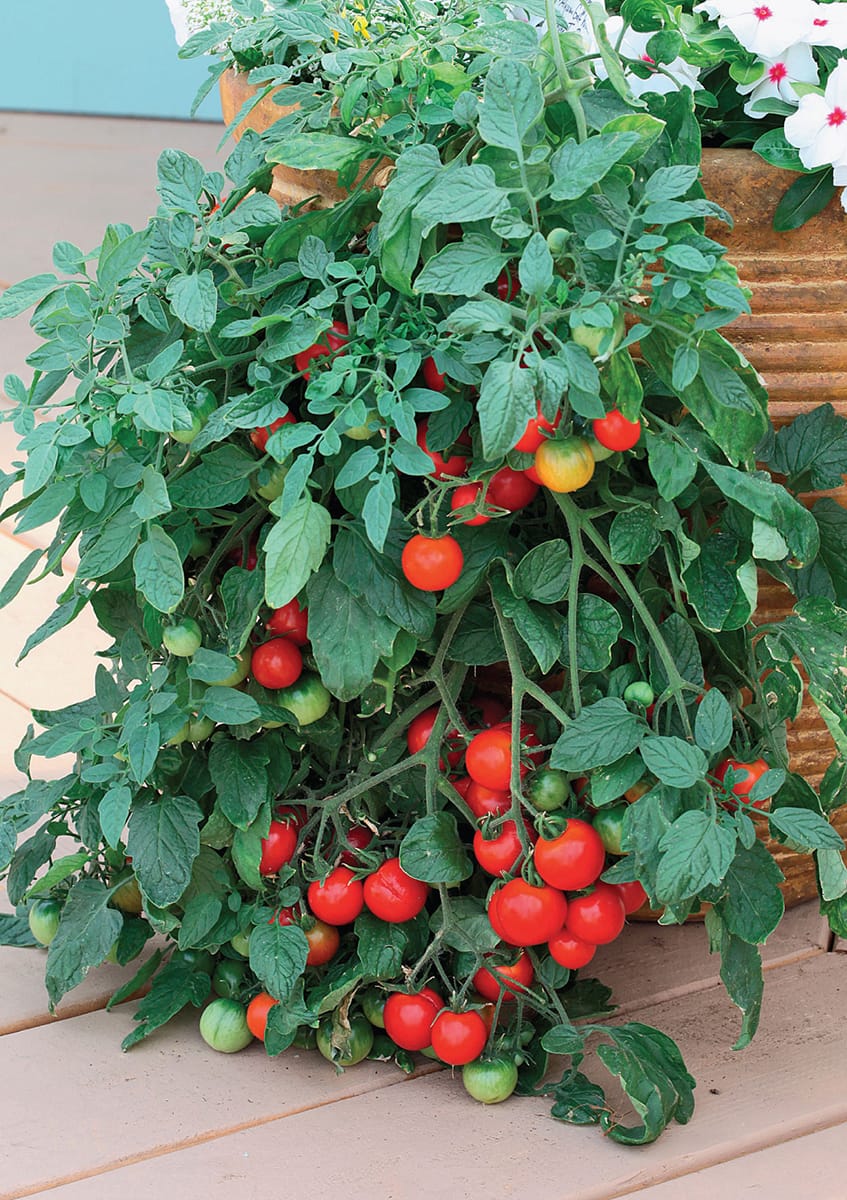
Sugar Pot Watermelon
COMMON NAME: Sugar Pot Watermelon
BOTANICAL NAME: Citrullus lanatus ‘Sugar Pot’
MATURE DIMENSIONS: 1 foot tall; 2 to 3 feet wide
PHYSICAL APPEARANCE: Patio- and small-garden friendly, this compact watermelon variety won’t take up a lot of real estate. Each plant produces two or three 5- to 8-pound fruits. ‘Sugar Pot’ is a hybrid variety with melons that are juicy and red fleshed. Its leaves are smaller than most other watermelon varieties, too.
PLANTING TIPS: Sow seeds directly into the garden several weeks after the danger of frost has passed and the soil temperature is about 80°F. Watermelons resent transplanting, so if you do start seeds indoors to get a jump on the growing season, use plantable peat pots and don’t disturb the roots when transplanting. Space the plants 5 feet apart or grow one vine per 5-gallon pot.
CARE REQUIREMENTS: Consistent moisture is key to good fruit production. The melons will crack if a dry spell is followed by excessive moisture. To ensure good pollination, plant near flowers.
HARVEST TIME: Summer
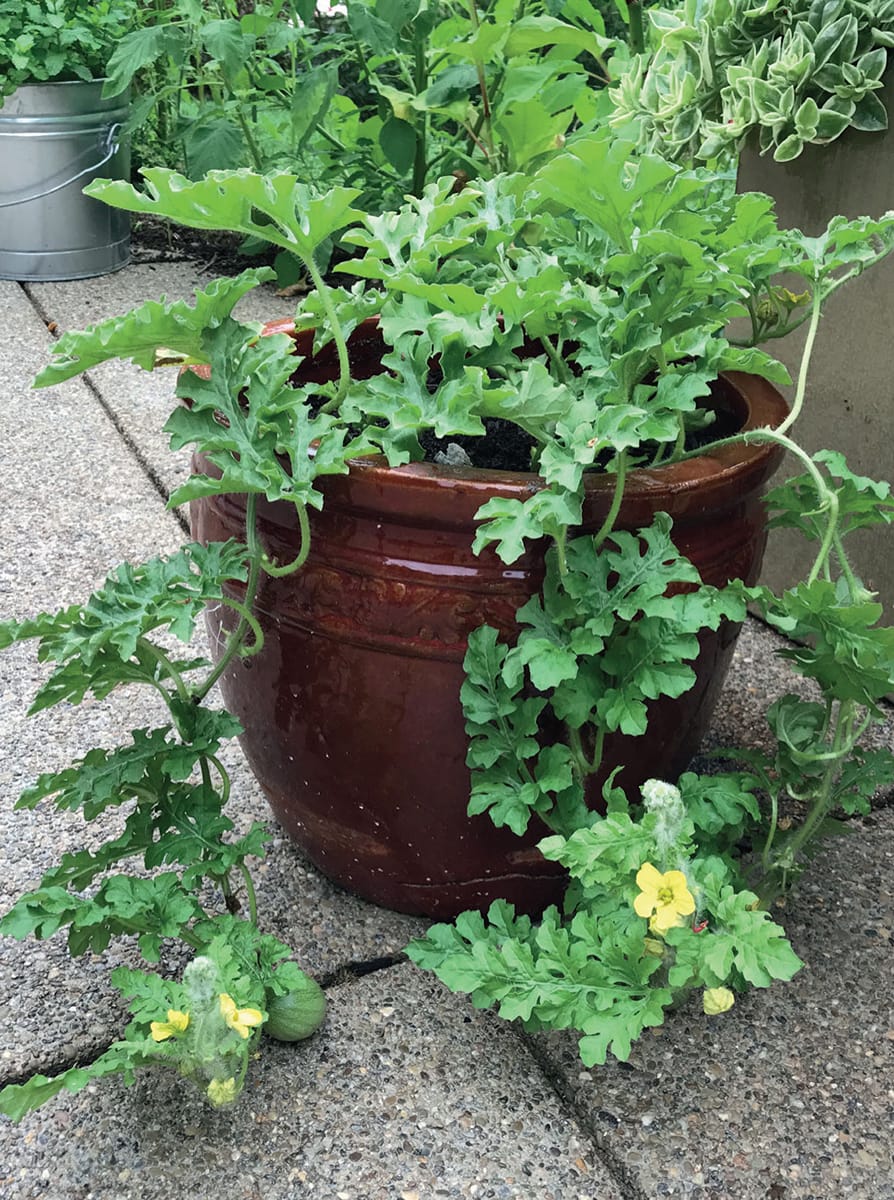
HERBS
Spicy Globe Basil
COMMON NAME: Spicy Globe Basil
BOTANICAL NAME: Ocimum basilicum ‘Spicy Globe’
MATURE DIMENSIONS: 1 foot tall; 1 foot wide
PHYSICAL APPEARANCE: A true herbal delight, ‘Spicy Globe’ basil offers a classic basil taste with a bit of a spicy bite. The globe-shaped plants are covered in dense branches of small, very aromatic leaves. The flowers are tiny and white and should be pinched off for the best foliage flavor. ‘Spicy Globe’ is a petite and uniform plant that makes a lovely edge for garden beds.
PLANTING TIPS: Purchase starter plants from a nursery or sow seeds indoors under grow lights 6 weeks before the last expected spring frost. Move the plants outdoors only when there’s no remaining threat of frost. The dense, compact growth habit of this variety means you can space them fairly close; 18 inches apart on center. Or, plant in mixed containers, hanging baskets, window boxes, or raised beds.
CARE REQUIREMENTS: Basil is not frost tolerant, so protect it from cold temperatures. Pinch the plants back regularly or harvest frequently for continuous production of new foliage.
HARVEST TIME: Early summer through frost

Fino Verde Basil
COMMON NAME: Fino Verde Basil
BOTANICAL NAME: Ocimum basilicum ‘Fino Verde’
MATURE DIMENSIONS: 10 to 12 inches tall; equal spread
PHYSICAL APPEARANCE: ‘Fino Verde’ is a compact, bushy basil that’s covered in flavorful, tiny leaves. It flowers much later than full-sized varieties, so you don’t have to pinch it back as frequently. With thick growth and a dense branching habit, ‘Fino Verde’ is both tidy and productive.
PLANTING TIPS: Purchase starter plants from a nursery, or sow seeds indoors under grow lights 6 weeks before the last expected spring frost. Space plants 18 inches on center, or grow one plant per 1-gallon container.
CARE REQUIREMENTS: This fast-growing variety requires very little care. Simply pinch off flowers as they’re produced and make regular harvests to encourage new, succulent growth. With this variety’s classic sweet basil taste, you can’t go wrong!
HARVEST TIME: Early summer through frost
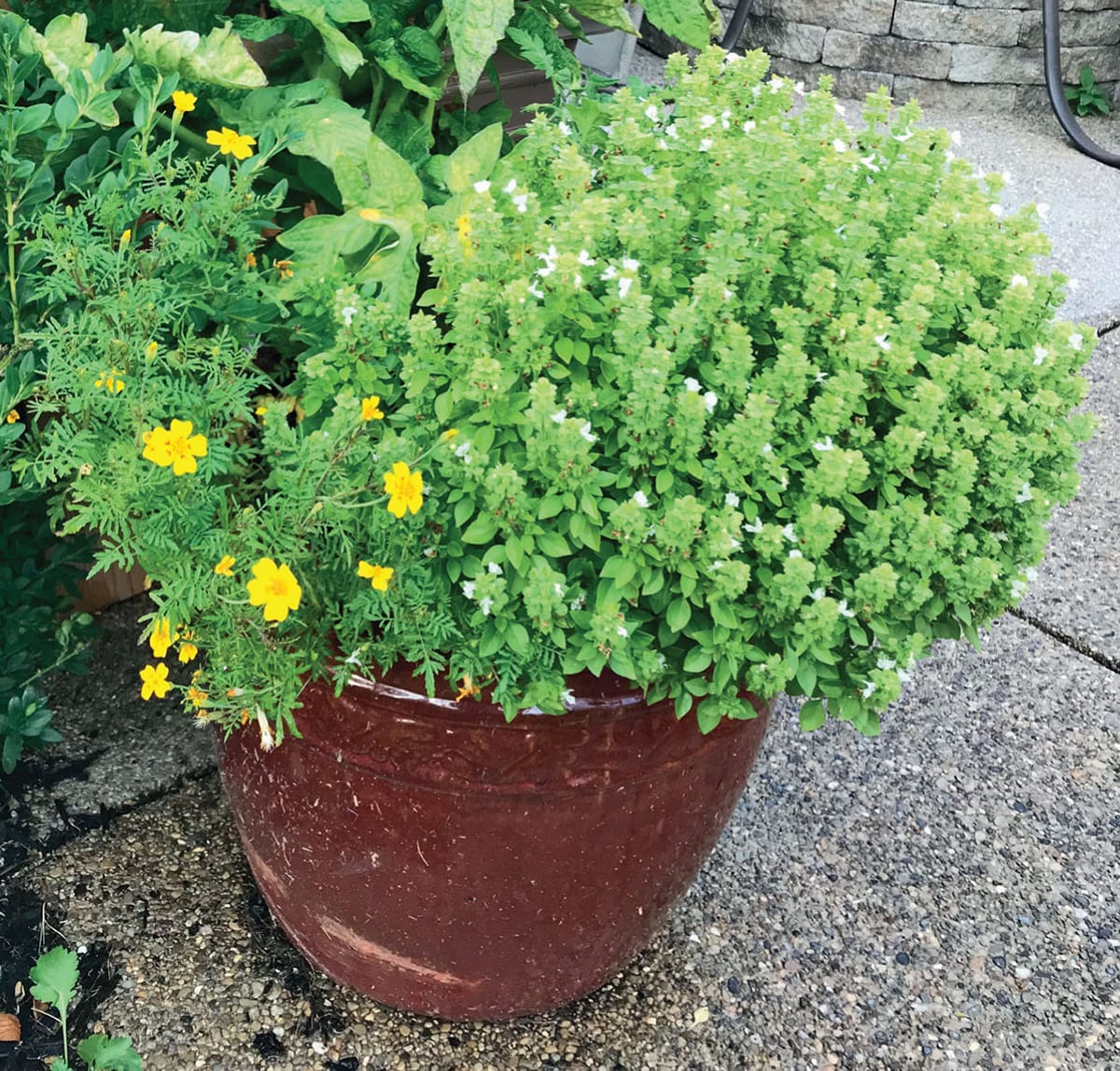
Everleaf Basil
COMMON NAME: Everleaf Basil
BOTANICAL NAME: Ocimum basilicum ‘Everleaf’
MATURE DIMENSIONS: 18 inches tall; 12 inches wide
PHYSICAL APPEARANCE: This variety boasts full-sized basil leaves on a compact plant! Very productive and decently resistant to downy mildew, ‘Everleaf’ bolts an average of 8 weeks later than standard sweet basil. That means very little pinching is required and the harvest is prolonged. Each leaf is 2 to 3 inches long with a classic sweet basil scent and flavor. Short stems between leaf nodes keep this variety compact.
PLANTING TIPS: Purchase transplants from a nursery, or sow seeds indoors under grow lights 6 weeks before the last expected spring frost. Basil is frost sensitive, so wait to move the plants outdoors until nights are consistently warm. Space plants 18 inches apart, or put one plant per 2-gallon container.
CARE REQUIREMENTS: Regular harvests generate new leaves; pick as often as you’d like. Pinch off flowers when they arrive for the best foliage flavor. Good air circulation is critical when growing basil.
HARVEST TIME: Early summer through frost
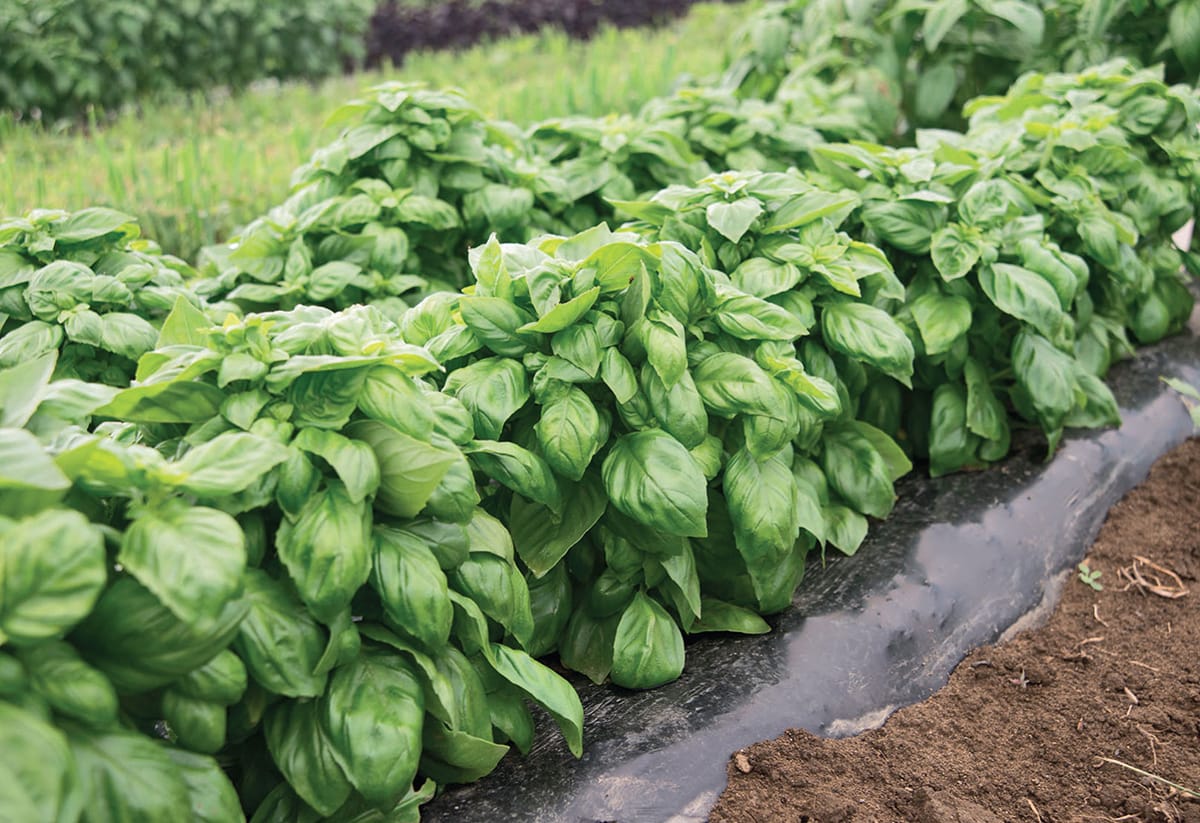
Elfin Thyme
COMMON NAME: Elfin Thyme
BOTANICAL NAME: Thymus serphyllum ‘Elfin’
MATURE DIMENSIONS: 1 to 2 inches tall; 12 to 18 inches wide
PHYSICAL APPEARANCE: This low-growing, tough perennial herb is not only good in the kitchen, it’s also good for pollinators. Lavender-pink flowers appear in early summer above tiny leaves with a classic thyme flavor.
PLANTING TIPS: ‘Elfin’ thyme can be started from seed sown indoors under grow lights about 10 weeks before the start of the gardening season, but it’s probably best to purchase starter plants from a nursery. The plants form a dense groundcover when spaced closely. Or, plant it in a mixed herb container, raised bed, or a small herb garden.
CARE REQUIREMENTS: Thyme is a very low-maintenance, drought-tolerant, tough plant that’s winter hardy down to –30°F. Trim back dead growth in the early spring and harvest the leaves as needed.
HARVEST TIME: Spring through fall
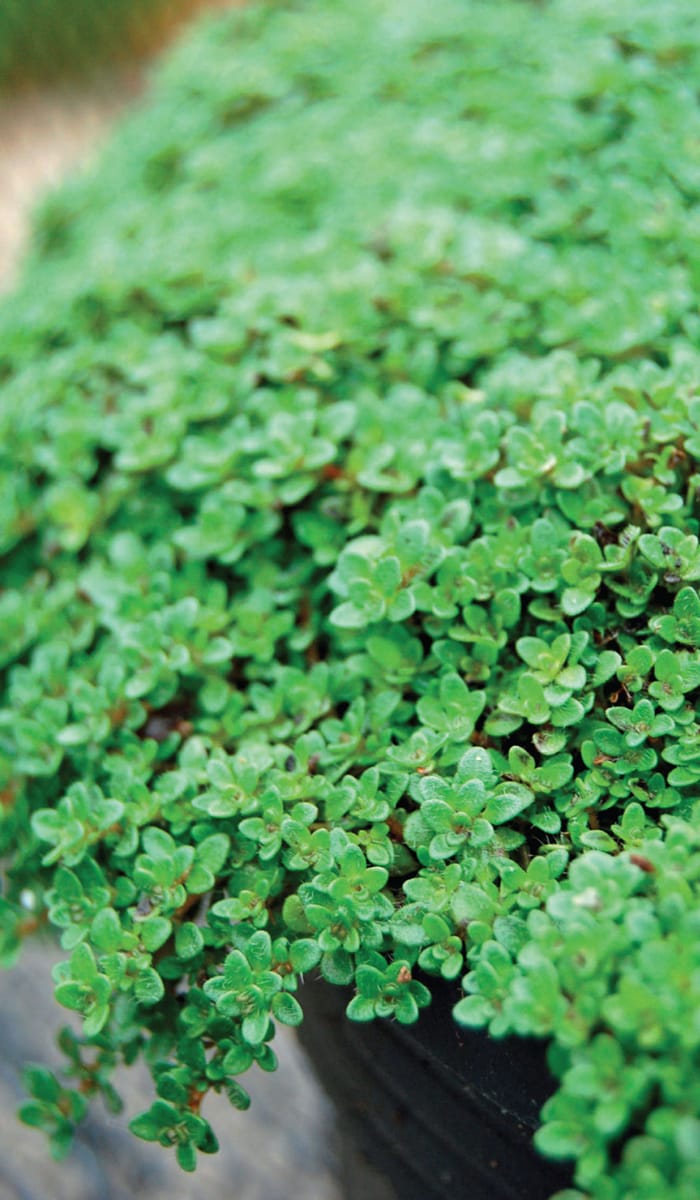
Sweet Marjoram
COMMON NAME: Sweet Marjoram
BOTANICAL NAME: Origanum majorana
MATURE DIMENSIONS: 12 to 18 inches tall; equal spread
PHYSICAL APPEARANCE: This naturally low-growing herb looks great as an edging, groundcover, or when planted in pots. The green leaves and knob-like clusters of white to pink flowers have a sprawling habit and a delicious flavor. Enjoyed fresh or dried, sweet marjoram is very versatile in the kitchen.
PLANTING TIPS: Start from seed sown indoors in late winter, or purchase starter plants from the nursery. A fairly slow-growing herb, sweet marjoram is not tolerant of frosts, so wait until warm temperatures arrive before planting outdoors.
CARE REQUIREMENTS: For maximum production, make continual harvests of the leaves and stems. Trim off the flowers for the best leaf production and flavor. At the end of the growing season, marjoram plants can be overwintered indoors on a sunny windowsill.
HARVEST TIME: Midsummer through frost
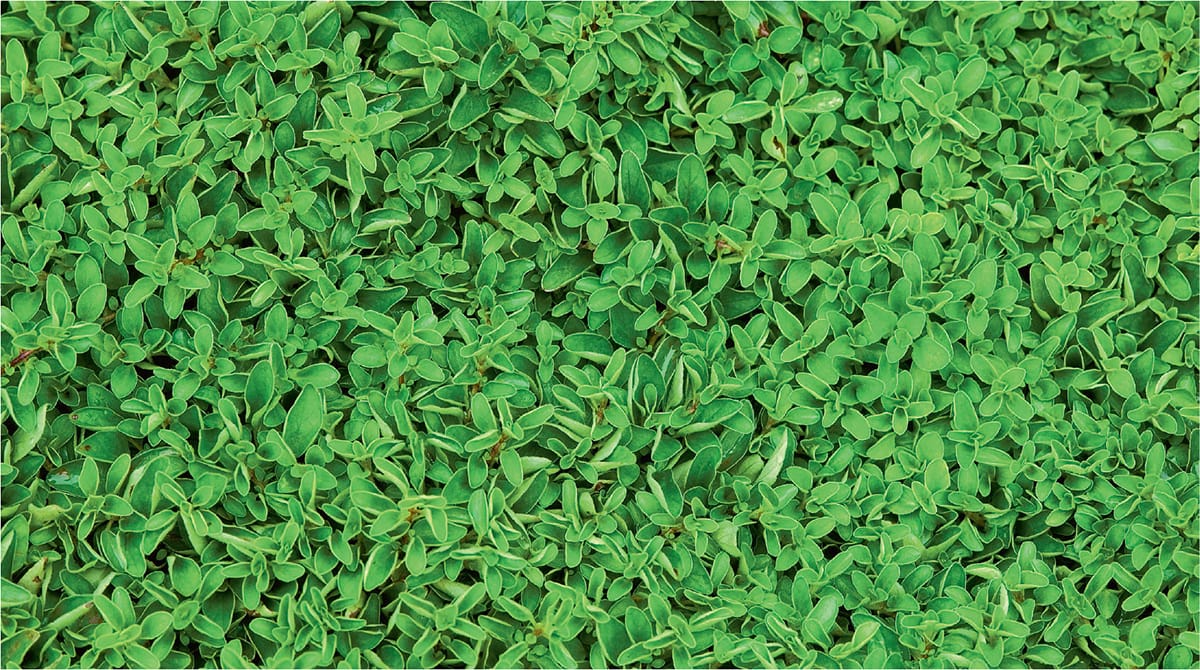
Fine Leaf Chives
COMMON NAME: Fine Leaf Chives
BOTANICAL NAME: Allium schoenoprasum ‘Fine Leaf’
MATURE DIMENSIONS: 12 inches tall; 10 inches wide
PHYSICAL APPEARANCE: The grass-like, slender, onion-flavored leaves of ‘Fine Leaf’ chives stay tender even when mature. Balls of pink to purple, edible flowers occur in the spring. The vase shape of this plant looks great in a garden border, container, or small herb garden.
PLANTING TIPS: Sow seeds directly into the garden 1/4 inch deep and 2 inches apart. Thin the resulting seedlings to 10 inches apart. It may be best, however, to purchase a starter plant from a nursery as most households really need only one or two plants. Chives are a perennial herb that’s winter hardy down to –40°F.
CARE REQUIREMENTS: Enjoy the fresh leaves throughout the growing season by cutting them off at their base. After flowering, cut the entire plant back to the ground to generate tender new growth.
HARVEST TIME: Spring to fall

Wega Parsley
COMMON NAME: Wega Parsley
BOTANICAL NAME: Petroselinum crispum ‘Wega’
MATURE DIMENSIONS: 10 to 12 inches; equal spread
PHYSICAL APPEARANCE: The upright growth habit of ‘Wega’ means it takes up less garden space than most other varieties. This curly leaved parsley variety produces dark green, classic parsley leaves with a clean taste and crisp texture. ‘Wega’ doesn’t turn bitter in the heat.
PLANTING TIPS: Sow seeds indoors under grow lights about 8 weeks before the last expected spring frost date. It may take 3 to 4 weeks for the seeds to germinate. Move the plants into the garden or outdoor containers at the start of the growing season. Space plants 1 foot apart.
CARE REQUIREMENTS: Well-drained soil is a must when growing parsley. Harvest the leaves regularly for continued production. Parsley is a cold-tolerant biennial herb that will overwinter in mild climates and flower at the start of its second season. After flowering, replace the plants with fresh stock for the best flavor.
HARVEST TIME: Spring through fall in the north; fall through spring in the south
